 |
PO Box 9021,
Wilmington, DE 19809, USA
E-mail: font@focusonnature.com
Phone: Toll-free in USA 1-888-721-3555
or 302/529-1876 |
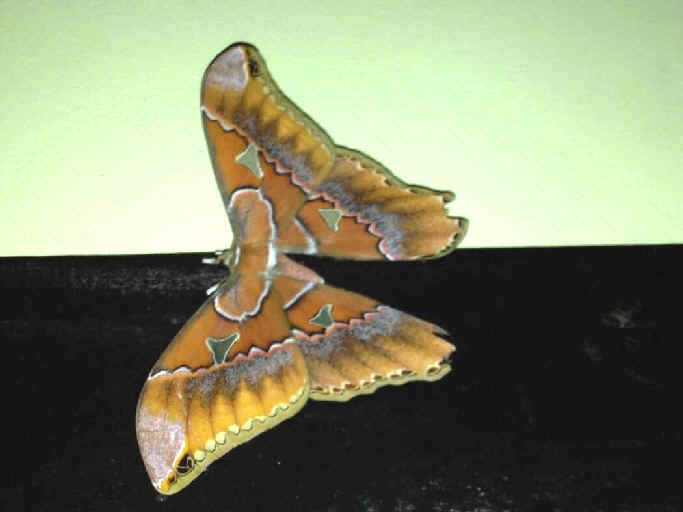 A
List
of Some
A
List
of Some
Moths
of Central America
including those
during
Focus On Nature Tours
This List of Central American Moths
compiled by Armas Hill
A LINK to a LIST of CENTRAL AMERICA BUTTERFLIES
Photo at upper right: an
ORIZABA SILKMOTH, Rothchildia orizaba
(photo by Francisco
Crespo, in October 2012, in Boquete, in western Panama)
Codes:
M#xxxx: MONA (Moths of North America)
Numbers.
These generally were
Hodge's Numbers, from the
"Check List of the Lepidoptera North of Mexico"
by R.W. Hodges et al.
That 1983 list (actually compiled thru 1978) is outdated, but those numbers have
been long used (and continue to be in the MONA listing).
Numbers noted as
(BMCR:xxx)
refer to plates with an illustration in the
book
"Butterflies & Moths of Costa Rica" by Isidro Chacon
& Jose Montero, 2007 (followed by -c: caterpillar,
-co: caterpillar only)
Numbers noted as
(ICR:xxx)
refer to pages with a photograph in the book
"Butterflies, Moths, and Other Invertebrates of Costa Rica, A Field
Guide" by Carrol Henderson, 2010 (ICR =
Invertebrates Costa Rica)
Numbers noted as (PNE:xxx)
refer to pages with illustrations in the "Field Guide to the Moths of
Eastern North America", by David Beadle & Seabrooke Leckie, 2012
Numbers noted as (W:xx)
refer to pages with a photograph in the book
"Caterpillars of Eastern North America" by David Wagner, 2005.
Numbers noted as (100BM:xx) refer to
numbered plates in the book "100 Butterflies and Moths, Portraits from
the Tropical Forest of Costa Rica", by Jeffrey Miller, Daniel Janzen,
Winifred Hallwachs, 2007
Numbers noted as (100C:xx) refer to numbered
plates in the book "100 Caterpillars, Portraits from the Tropical Forest
of Costa Rica", by Jeffrey Miller, Daniel Janzen, Winifred Hallwachs, 2007
For both of these books, codes followed by -c:
indicates that there is in
the book a photograph of the caterpillar.
Actually for all of the species in both books, there are photographs of
caterpillars and the adult butterflies and moths.
To view the caterpillar and adult butterfly and moth photos online go to:
http://janzen.sas.upenn.edu/caterpillars/database.lasso
BZ: in Belize
CR: in Costa Rica
GU: in Guatemala
HN: in Honduras
pb: at Pico Bonito
Lodge, in the Caribbean lowlands
MX: in Mexico
PN: in Panama
(ph): species with a photo in the FONT website
An excellent source for the moths noted here as occurring
in Belize is the website "Moths of Belize" by Matthew
Barnes.
Some of the information in that site is from the published "Lepidoptera
of Belize" in 1999 by Jan Meerman.
HERE'S A LINK TO THE MOTHS OF BELIZE WEBSITE:
http://www.mbarnes.force9.co.uk/belizemoths/belizehome.htm
There is a link below to a website with some fine photos of moths in Honduras,
a photo gallery by Tom Murray.
In the site, the photos are not in any order, and a number of them in the latter
part of the gallery are unidentified,
but for those that are, it is an excellent place to see what the moths look
like.
In the list here, species having a photograph in Tom Murray's gallery are
coded: (ph:TM)
HERE'S A LINK TO THE MOTHS IN HONDURAS PHOTO GALLERY:
http://www.pbase.com/tmurray74/honduras_moths
An extremely good source for information in this list regarding Central American
moths and those in particular in Honduras, is "An Annotated List of the
Lepidoptera of Honduras", published by the University of Nebraska in
the US in February 2012.
The work was the collaborative effort of authors, whose names follow, from the
Florida Museum of Natural History at the University of Florida, the National
Museum of Natural History and the Smithsonian Institution both in Washington DC,
and the Museo de Mariposas y Insectos in La Ceiba in Honduras.
The authors are: Jacqueline Miller, Deborah Matthews. M. Alba Solis, Donald
Harvey, Patricia Gentili-Poole, Robert Lehman, Thomas Emmel, and Charles Covell
Jr.
Some of the surveys of moths and butterflies for this work were conducted
at the Pico Bonito Lodge in the Caribbean lowlands in Honduras.
Those found there are coded in the list with a pb after HN for
Honduras.
All of the FONT birding and nature tours that have been done in Honduras
included stays at the Pico Bonito Lodge,
a place not only good for lepidoptera, but also for birds including both Lovely
and Snowy Cotingas.
In this listing, there is some updated taxonomy with the family EREBIDAE containing
moths that were formerly classified in the family NOCTUIDAE, plus all of
the former members of the families ARCTIIDAE and LYMANTRIIDAE.
This re-classification has not yet met with general consensus, and many
resources and publications still follow the older classification scheme.
As of now, there are about 1,830 species of moths in this list.
Among
the Moth Groupings in the following list, links to these families:
Uraniidae:
Scoopwings positioned
at the beginning of the list due to their attractiveness, would be by
GEOMETRIDAE
MICROMOTHS:
Yponomeutidae: Ermine Moths
Cossidae: Cossid Millers
Megalopygidae: Flannel Moths Aididae Limacodidae: Cupmoths
Dalceridae Lacturidae
Zygaenidae Mimallonidae
Lasiocampidae
Eupterotidae Bombycidae
In BOMBYCIDAE
(above), are the subfamiles APATELODINAE, PHIDITIINAE, BOMBYCINAE.
Pyralidae:
Pyralid, or Snout Moths What
has been CRAMBIDAE included in PYRALIDAE
Thyrididae
MACROMOTHS:
Hedylidae: Butterfly Moths Castniidae: Giant Butterfly
Moths
Geometridae: Geometer Moths
(Loopers, Inchworms,
Spanworms)
Subfamilies in GEOMETRIDAE
include: ENNOMINAE, GEOMETRINAE (the Emeralds),
LARENTIINAE (Carpets and Pugs), OENOCHROMINAE, STERRHINAE
Saturniidae: Giant Silkmoths
Sphingidae: Sphinx Moths
Lymantriidae: Tussock Moths
Sematuridae: American Swallowtail Moths Notodontidae: Prominents
Dioptinae Doidae
DIOPTINAE (above) is a
distinctive subfamily in the family NOTODONTIDAE.
Erebidae:
subfamily Herminiinae: Litter Moths Erebidae: subfamily
Erebinae (was Catocalinae)
In the above link, in
with subfamily EREBINAE are those in subfamilies OPHIDERINAE and
SCOLIOPTERYGINAE.
Erebidae: subfamilies
Anobinae, Eublemminae, Phytometrinae, Hypocalinae
Erebidae: subfamilies Hypeninae, Calpinae, Eulepidotinae
In the above link, HYPENINAE
are the SNOUTS.
Arctiinae: Tiger Moths, Ctenuchini: Wasp Moths,
Lithosiini: Lichen Moths
Also included in the
above link are the tribes: EUCHROMIINI, PERICOPINI, PHAEGOPTERINI
Euteliidae Nolidae
The families EUTELLIDAE
and NOLIDAE closely related to NOCTUIDAE (below).
In this list with EUTELIIDAE are those in the subfamily STICTOPTERINAE (of
NOCTUIDAE).
In NOLIDAE are the NOLID or TUFT MOTHS, including the subfamilies CHLOEPHORINAE,
SARROTHRIPINAE, NOLINAE.
The families EUTELIIDAE and NOLIDAE are in the NOCTUOIDEA superfamily.
.
Noctuidae: subfamilies Plusiinae, Bagisarinae, Acontiinae, Acronictinae,
Cucullinae, Xyleninae
PLUSIINAE (in the link above)
includes LOOPERS and MILLER MOTHS.
ACONTIINAE are the BIRD-DROPPING MOTHS.
CUCULLINAE are the HOODED OWLETS.
Also included (in the link above), with CUCULLINAE, is the subfamily
ONCOCNEMIDINAE
Noctuidae: subfamilies
Agaristinae, Condicinae, Amphipyrinae, Eriopinae, Hadeninae, Heliothinae
In AGARISTINAE are the
WOOD-NYMPHS and FORESTERS.
CONDICINAE are the GROUNDLINGS.
HELIOTHINAE are the FLOWER MOTHS.
Included (in the link above), with HADENINAE, are moths in the tribe PHOSPHILINI,
and those in the genus GONODES, said by some to be in the tribe ELAPHRIINI
(below, in NOCTUINAE)
Noctuidae:
subfamilies Cydosiinae, Diphtherinae, Eustrotiinae
In DIPHTHERINAE is the
Hieroglyphic Moth.
Noctuidae:
subfamily Noctuinae
In NOCTUINAE are the
tribes: DYPTERYGIINI, ELAPHRIINI (the Midgets), LEUCANIINI (the Wainscots),
NOCTUINI (the Darts).
Other
Links:
Upcoming Birding & Nature
Tours in the Central America Upcoming FONT Tours Elsewhere
Alphabetical Directory of Moths by Genus with Photos in the FONT Website
Other Photo Galleries & Lists of:
Butterflies, Moths,
Dragonflies & Damselflies
Birds
Mammals Amphibians,
Reptiles Marine Life
Plants
Links to Lists of Moths with some Photos
in:
Eastern North America The West Indies
South
America Europe Japan


Photographed in Panama, this
large moth is known as the White Witch.
Large it is, up to 12 inches across.
Two more photos of this moth, and another of the Black Witch,
are in the list below, in the family Erebidae.
(above photo by James Audlin)
The following is from the book
"Butterfly People. An American Encounter
with the Beauty of the World", by William Leach, published in 2013,
comparing moths to butterflies:
"Moths and butterflies both belong to the same order, Lepidoptera. Each
undergo a complete metamorphosis and each are with wings covered by scales,
shingled one upon another, and stamped with color that contributes to the total
"tiled mosaic" of the wing.
Both have a proboscis, or a long, slender, coiled-up tube attached to the head,
which the insects uncoil to suck nectar from many kinds of flowers, pollinating
as they go. As caterpillars, however, they are much more choosy, with some
dependent on only one food plant, others on a few, and still others on many
different species of plants.
Both moths and butterflies are cold-blooded, requiring an infusion from the heat
of an ambient atmosphere.
But even with their similarities, the differences between moths and butterflies
abound.
In the most general terms, the majority of moths have feathery, tapered
antennae. These, like radar, guide them through the dark, and the males rely on
them to pick up the scent of females.
Butterflies generally have clubbed or hooked antennae, used to smell and track
down nectar, and for sexual purposes.
Moths have thick, commonly hairy bodies and large multifaceted, compound eyes
and usually inhabit the night, while the majority of butterflies fly by day and
have smaller eyes and thinner, relatively hairless bodies.
The classic exception for moths are those belong to the URANIIDAE family. They
look like butterflies in nearly every respect and are among the most stunning
diurnal lepidoptera in the world."
Our list of moths here begins with those in the Family URANIIDAE.
A List of selected Moths in
Central America:
Family
URANIIDAE, Subfamily URANIINAE: the SCOOPWINGS
URANIIDAE is a widely distributed family in the world.
Worldwide, there are
about 700 species in some 90 genera.
About 40 species have
been found in Costa Rica.
In the subfamily
URANIINAE, in Costa Rica there is only 1 species,
the GREEN URANIA,
or "GREEN DUCKTAIL".
- Urania fulgens (ph)
______ M#7658 BZ CR(*)
HN
(BMCR:189) (ICR:113)
URANIA SWALLOWTAIL MOTH (or
Green Urania, or Green Page Moth)
Urania fulgens is undoubtedly one of the most spectacular of the day-flying
moths in Central America. It could be misidentified as a swallowtail
butterfly, but actually its wing pattern is unlike any swallowtail in the
region.
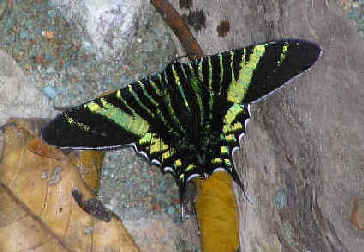
Above: a Urania Swallowtail Moth photographed during a FONT
Tour
in Costa Rica (above photo by Rosemary Lloyd)
Below: another Urania Moth photographed in Costa Rica in March 2015
(photo below courtesy of Eileen Antolino, photo by Guilia Iannitelli)
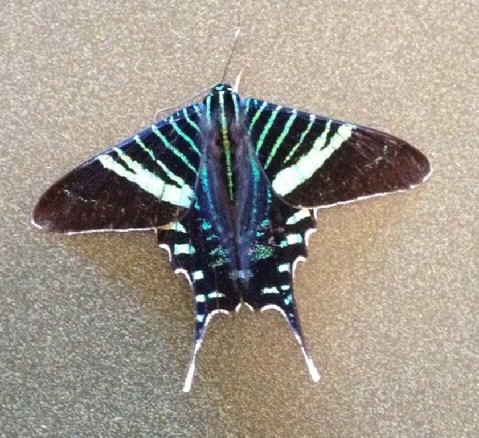
Family URANIIDAE, Subfamily EPIPLEMINAE
- Aniplecta sp. ______ HN pb
- Epiplema sp. ______ HN pb
- Erosia birostrata ______
CR (BMCR:190)
- Erosia veninotata ______
CR (BMCR:190,191c)
- Nedusia cuticulata ______
CR (BMCR:190)
- Nedusia mutilara ______ CR
(BMCR:190)
- Nedusia placidaria ______ CR (BMCR:190,191c)
- Philograula slossoniae ______ HN pb
- Schidax squamaria ______ CR (BMCR:191co)
- Syngria depranata ______ CR (BMCR:190)
Family YPONOMEUTIDAE: ERMINE MOTHS
- Atteva aurea (phTM)
______ M#2401
HN
AILANTHUS WEBWORM
MOTH
Family COSSIDAE, Subfamily COSSULINAE: the COSSID MILLERS,
or CARPENTER MILLERS
COSSIDAE
is a cosmopolitan family. Worldwide, about 700 species have been identified.
93 species have been found in Costa Rica.
- Allostylus coerulescens ______ CR
(BMCR:22)
- Morpheis pyracmon ______ BZ
Non-specific members of COSSIDAE are illustrated in BMCR:18-22, in the
subfamilies or genera: Cossinae, Cossulinae, Hypoptinae, Zeuzerinae.
Family MEGALOPYGIDAE: the
FLANNEL MOTHS, also called the CRINKLED FLANNEL MOTHS
MEGALOPYGIDAE
is restricted to the New World. It greatest diversity is found in the
Neotropics. About 240 species have been described, mainly in Central America
and South
America. Some are in North America. 42 species have been found in Costa
Rica.
Species in MEGALOPYGIDAE have long, soft-looking fur resembling a
fluffy cat. But beneath the furry hair of the caterpillars there are spines
that can deliver painful stings and severe medical problems, even
unconsciousness.
- Aithorape roseicornis ______ CR
(BMCR:2)
- Hysterocladia eriphua ______ CR
(BMCR:2)
- Macara argentea ______ CR
(BMCR:2)
- Megalopyge albicollis ______ BZ
CR HN (BMCR:2c,eggs)
- Megalopyge basalis ______ CR
(BMCR:6co)
- Megalopyge hina ______ CR
(BMCR:6cocoon)
- Megalopyge lampra ______ BZ
HN
- Megalopyge lanata ______ CR
(BMCR:2,5c)
- Megalopyge opercularis ______ BZ
CR
(BMCR:2,6c)
- Megalopyge salebrosa ______ CR
(BMCR:2)
- Megalopyge sp.
______ CR (ICR:93)
- Mesoscia dumilla ______ BZ
- Mesoscia terminata ______ CR
(BMCR:2)
- Mesoscia unifascia ______ CR
(BMCR:3)
- Norape argyrorrhoea ______ CR
(BMCR:3)
- Norape nevermanni ______ CR
(BMCR:3)
- Podalia contigua ______ BZ
CR
(BMCR:3)
- Podalia orsilocha ______ CR
(BMCR:3)
- Podalia thanathos ______ CR
(BMCR:3)
- Podalia tympania ______ CR
(BMCR:3)
- Podalia walkerensis ______ CR
(BMCR:4)
- Thoscora acca ______ CR
(BMCR:5c)
- Thoscora xinga ______ CR
(BMCR:4)
- Trosia dimas ______ CR
(BMCR:4)
- Trosia janzen01
______ CR
(100BM:2-c)
- Trosia fallax ______ BZ
- Trosia incostata ______ CR
(BMCR:4)
- Trosia nigropunctigera ______ CR
(BMCR:4)
Family AIDIDAE
Moths of medium size.
The forewings often have a grayish coloration that contrasts with the
hindwings, which are reddish.
Only 2 genera are known in the family, with 6 known species. In Costa Rica,
2 species are known.
- Aidos amanda ______
CR (BMCR:7)
- Aidos perfusa ______ CR
(BMCR:7)
Aidos perfusa admiranda ______ CR
(BMCR:7)
Family LIMACODIDAE (or EUCLIDAE):
Called SLUGMOTHS because the caterpillars resemble slugs, or CUPMOTHS
because of the shape of the cocoons. Mostly tropical, but occur worldwide, with
about 1,000 described species.
LIMACODIDAE is a very common family in the tropics, but it does occur in
all of the world's zoogeographical regions. Worldwide, about 1,000 species have
been identified. In Costa Rica, 117 species have been found.
Adult moths in LIMACODIDAE do not feed.
- Acharia horrida ______
CR (100C:73-c)
- Acharia hyperoche ______ CR
(BMCR:9co) (100C:44-c)
- Archaria nesea ______ CR
(BMCR:8)
- Acharia ophelians ______ CR
(BMCR:8)
- Euclea norba ______ BZ
CR (100C:68-c)
The caterpillar of Euclea norba
resembles a piece of lichen.
- Euclea zygia ______ CR
(BMCR:8)
- Euphobetron aquapennis ______ CR
(BMCR:8)
- Euprosterna elaea ______ CR
(BMCR:11co)
- Natada daona ______ CR
(BMCR:10co)
- Natada fusca ______ CR
(BMCR:9co)
- Parasa cebrenis (phTM)
______ HN
- Parasa cuernavaca ______ CR
(BMCR:11co)
- Parasa joanae ______ CR
(BMCR:9co)
- Parasa macrodonta ______ CR
(BMCR:10co)
- Parasa sandrae
______ CR (100C:77-c)
- Parasa viridogrisea ______ CR
(BMCR:11co)
- Parasa wellesca ______ CR
(BMCR:8)
- Perola monomania (phTM) ______ BZ
HN
- Perola villosipes ______
CR (BMCR:8)
- Phobetron hipparchia ______ CR
(BMCR:11co) (100C:27-c)
- Prolimacodes triangulifera ______
CR (BMCR:8)
- Prolimacodes undifera ______ CR
(BMCR:10co)
- Semyra bella ______ CR
(BMCR:8)
- Talima aurora ______ CR
(BMCR:8)
Family DALCERIDAE
Small to medium-sized moths. Orange, white, or yellow. Stout with a
hairy body. Abdomen very scaly, with wide and rounded wings. Flight is weak,
erratic and undulated, with tremulous flapping.
A Neotropical family. About 85 species are known, of which 16 have been found
in Costa Rica.
- Acraga coa ______
BZ CR (BMCR:12,13c)
- Acraga hamata ______
CR (BMCR:12,13c) (100C:78-c)
- Acraga infusa ______ CR
(BMCR:12)
- Acraga isothea ______ CR
(BMCR:12)
- Dalcerides alba ______ CR
(BMCR:12)
- Dalcerides mesoa ______ CR
(BMCR:12)
- Dalcerides sofia ______ CR
(BMCR:12,13c)
- Paracraga argentea ______ CR
(BMCR:12)
Family LACTURIDAE
Mostly attractively-colored moths. In a tropical or subtropical family,
in Central America and South America.
In Costa Rica, 9 species have been found.
- Lactura citrina ______ CR
(BMCR:14)
- Lactura euthoracica ______ CR
(BMCR:14)
- Lactura irrorata ______ CR
(BMCR:14)
- Lactura schenoxantha ______ CR
(BMCR:14)
- Lactura spatula ______ CR
(BMCR:14)
Family ZYGAENIDAE
Moths of diurnal habits, with aposematic coloration. Only a few species
are attracted to light.
A cosmopolitan family, but out of about a thousand species, only about 9
have been found in Costa Rica.
- Neoalbartia anacreon ______ CR
(BMCR:16)
- Neoprocris flora ______ CR
(BMCR:16)
Family MIMALLONIDAE
Small to medium-sized moths, with wide scaly wings. Bodies are stout and
thick, very scaly.
The species in this family are in the Neotropics, with 4 species found in
the Nearctic.
About 200 species in 27 genera have been described. About 80 species are
known in Costa Rica.
- Cicinnus dulcis ______ CR
(BMCR:26)
- Cicnnus joanna (phTM) ______ CR
HN
(BMCR:26)
- Cicnnus motagus (phTM)
______ HN
- Cicinnuus pudens ______ CR
(BMCR:26)
- Druentica inscita ______ CR
(BMCR:27co)
- Druentica partha ______ HN pb
- Lacosoma syrinx ______ CR
(BMCR:26)
- Mimallo amilia ______ CR
(BMCR:26,27c) (100BM:44)
Mimallo amilia is a
pest to the guava fruit, Psidium
guajaba.
- Roelmana maloba (phTM) ______ CR
HN pb
(BMCR:26)
- Roelofa hegewischi ______ CR
(BMCR:26)
Family
LASIOCAMPIDAE
Mostly small, but a few large moths, with wide wings
and stout bodies.
The males of some species with diurnal habits have small compound eyes with
long intermatidial setae.
Diurnal males fly quickly. Otherwise, generally, adults are attracted to
light.
A cosmopolitan family, better represented in tropical countries. About 1,500
species in 150 genera. In Costa Rica, about 130 species have been found.
Adult moths in LASIOCAMPIDAE do not feed. They live only 5 to 10
days.
- Artace cribraria (phTM)
______ HN pb
DOT-LINED WHITE
- Euglyphis albigrisea ______
CR (BMCR:28)
- Euglyphia amathuria ______ CR
HN pb
(BMCR:33co)
- Euglyphia amisena ______ HN
- Euglyphia asapha ______ CR
(BMCR:33co)
- Euglyphia canifascia ______ HN
- Euglyphis canities ______ CR
(BMCR:28)
- Euglyphis capillata ______ CR
(BMCR:28)
- Euglyphis carola ______ CR
(BMCR:28)
- Euglyphis celebris ______ CR
(BMCR:28)
- Euglyphis cercina ______ HN
- Euglyphia charax ______ CR
(BMCR:33co)
- Euglyphis definita ______ CR
(BMCR:28)
- Euglyphia directa ______ CR
(BMCR:29)
- Euglyphis durtea ______ CR (BMCR:28)
- Euglyphia elena ______ CR
(BMCR:28)
- Euglyphia gutturalis ______ CR
HN (BMCR:29,34c)
Euglyphia gutturalis gutturalis ______ CR
(BMCR:29,34c)
- Euglyphia janzen01
______ CR (100C:98-c)
- Euglyphia juliana ______ CR
(BMCR:29)
- Euglyphia lanea ______ CR
(BMCR:29)
- Euglyphia lankesteri ______ CR
(BMCR:29,34c)
- Euglyphia laronia ______ CR
(BMCR:29)
- Euglyphia laverna ______ CR
(BMCR:29)
- Euglyphia lepta ______ CR
(BMCR:34co)
- Euglyphia maria ______ CR
(BMCR:33co)
- Euglyphia melancholica ______ CR
(BMCR:29)
- Euglyphia phyllis ______ CR
(BMCR:35c)
- Euglyphia poasia (phTM) ______ CR
HN pb
(BMCR:30)
- Euglyphia scaptia ______ CR
(BMCR:30)
- Euglyphia scripturata ______ CR
(BMCR:30)
- Euglyphia submarginalis ______ CR
(BMCR:30,35c)
- Euglyphia thyatira ______ CR
HN pb
(BMCR:30)
- Euglyphia torrida ______ CR
(BMCR:30)
- Euglyphia varma ______ CR
(BMCR:30)
- Euglyphia zurcheri ______ HN pb
- Eutachyptera psidii ______ CR
HN (BMCR:30)
- Gloveria balloui ______ CR
(BMCR:31)
- Nesara caramina ______ CR
(BMCR:31)
- Nesara casada ______ CR
HN pb
(BMCR:31,34c)
- Nesara francesca ______ CR
(BMCR:31)
- Prorifrons rufescens ______
CR (BMCR:32)
- Prorifrons tremula ______ CR
(BMCR:32)
- Titya bella ______ CR
(BMCR:32)
- Tolype caieta ______ CR
HN pb
(BMCR:32)
- Tolype nana ______ CR
(BMCR:32,35c)
- Tolype perplexa ______ CR
(BMCR:32)
Family
EUPTEROTIDAE
Small to large wide-winged moths, with some females having diurnal habits.
A cosmopolitan family with about 300 species described in about 30 genera.
Only 3
species have been found in Costa Rica.
- Neopreptos marathusa ______ CR
(BMCR:36co)
Family BOMBYCIDAE
Small to large moths, wide-winged. At rest, they tend to let the forewings
hang and keep the hindwings away from the thorax. The abdomen tends to be
folded upward or to the sides.
The family is well represented in the Neotropical region. Close to 350
species in 40 genera are known. In Costa Rica, about 80 species have been
found.
Adult moths in BOMBYCIDAE do not feed.
Family BOMBYCIDAE, Subfamily
APATELODINAE
- Apatelodes albipunctata
______ CR (BMCR:37)
- Apatelodes ardeola
______ CR (BMCR:37)
- Apatelodes adrastia
______ CR (BMCR:40co)
- Apatelodes firmiana
______ CR (BMCR:37,39c)
- Apatelodes inviolata
______ CR (BMCR:37)
- Apatelodes lapitha
______ CR (BMCR:37)
- Apatelodes merlona
______ CR HN pb (BMCR:37,40c)
- Apatelodes pandara
______ CR (BMCR:37)
- Apatelodes pandarioides
______ CR (BMCR:38)
- Apatelodes paratima
______ CR (BMCR:38)
- Apatelodes pudefacta
______ CR (BMCR:38,39c)
- Apatelodes sericea
______ CR (BMCR:38)
- Apatelodes satellitia ______ HN
pb
- Apatelodes turralba
______ CR (BMCR:38)
- Depratelodes umbrilinea
______ CR (BMCR:38)
- Ephoria lybia
______ CR (BMCR:38)
- Olceclostera indentata ______ HN pb
- Prothysana felderi ______ CR
PN (BMCR:39co) (100C:74-c) (was
Tarchon felderi)
SHAG-CARPET CATERPILLAR
The range of Prothysana felderi is
from Mexico south to at least Ecuador.
There was a postage stamp depicting both the caterpillar and the
adult moth of Prothysana felderi issued
in Panama in 2002.
- Sorocara janzen01 _____ CR
(100C:76-c)
- Zanola verago
______ CR (BMCR:39co)
Family BOMBYCIDAE,
Subfamily PHIDITIINAE
Those in the genus PHIDITIA
were in the family APATELODIDAE.
- Phiditia cuprea
______ CR (BMCR:42co)
- Phiditia lucernaria
______ CR
(BMCRL42co) (100C:57-c)
- Phiditia maculosissima
______ CR (BMCR:41)
- Rolepa innotabilis
______ CR (BMCR:41)
- Rolepa nigrostriga
______ CR (BMCR:41)
Family BOMBYCIDAE,
Subfamily BOMBYCINAE, Tribe EPIINI
- Colla coelestis
______ CR HN pb (BMCR:43)
- Colla rhodope
______ CR (BMCR:43,45c)
- Epia casnonia (phTM)
______ CR HN pb (BMCR:43)
- Epia muscosa (phTM)
______ CR HN pb (BMCR:43,45c)
(100BM:22-c)
- Quentalia cameloi
______ CR (BMCR:44)
- Quentalia ficus
______ CR (BMCR:44)
- Quentalia numalia
______ CR (BMCR:44)
- Quentalia subumbrata
______ CR (BMCR:44)
- Quentalia surynorta
______ CR (BMCR:44)
- Anticla antica
______ CR (BMCR:44)
- Tamphana marmorea
______ CR (BMCR:44)
Family PYRALIDAE: the PYRALID, or SNOUT MOTHS
Included in this grouping is
what has been CRAMBIDAE, the subfamily PYRAUSTINAE (including SPILOMELINAE)
Subfamily PYRALINAE
follows after this list.
- Agathodes designalis (ph)
______ M#5240 BZ
SKY-POINTING MOTH
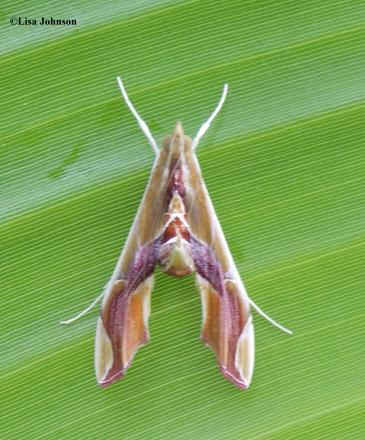
the
Sky-pointing Moth, Agathodes designalis
(copyrighted photo by Lisa Johnson)
- Anania inclusalis ______ BZ
- Aponia major ______ BZ
- Arthromastix lauralis ______ BZ
- Asturodes fimbriauralis ______ BZ
- Ategumia dilecticolor (phTM) ______
BZ HN occurs in Mexico,
Guatemala, Honduras
- Ategumia ebulealis ______ BZ
- Azochis trichotarsalis ______ BZ
- Bicilia lentistrialis ______ BZ
- Cacozelia elegans (phTM) ______
M#5587 HN
in subfamily EVERGESTINAE
ELEGANT CACOZELIA
- Coenostolopsis apicalis ______ BZ
- Conchylodes erinalis ______ BZ
- Conchylodes nolckenialis (phTM) ______
BZ HN
- Conchylodes platinalis ______ BZ
- Cryptobotys zoilusalis ______ BZ
- Desmia bajulalis ______ BZ
- Desmia funebralis ______
M#5159 BZ
GRAPE LEAFFOLDER MOTH
- Desmia ploralis ______ M#5167
BZ
MOURNFUL DESMIA MOTH
- Desmia ufeus ______
BZ
- Diacme mopsalis ______ BZ
- Diaphania costata ______ BZ
- Diaphania elegans ______
M#5207.1 BZ
- Diaphania esmeralda ______ BZ
- Diaphania glauculalis (phTM) ______
BZ CR HN PN occurs
in Belize, Honduras, Costa Rica, Panama, Ecuador
- Diaphania hyalinata (ph) ______
M#5204 BZ (species described by Linnaeus
in 1767)
MELONWORM MOTH
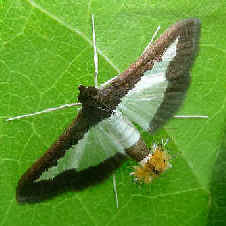
Melonworm Moth
- Diaphania lucidalis ______ BZ
- Diaphania nitidalis ______
M#5202 BZ
PICKLEWORM MOTH
- Diaphania phlebitis ______ BZ
- Dichocrocis sabatalis ______
BZ
- Epipaschia superatalis (phTM) ______
M#5577 HN in subfamily EPIPASCHIINAE
DIMORPHIC MACALIA
MOTH
- Eulepte gastralis ______ BZ
- Galleria mellonella (phTM)
______ M#5622 HN
in subfamily GALLERNINAE
GREATER WAX MOTH (or HONEYCOMB
MOTH)
- Glyphodes sibillalis ______
M#5198 BZ
MULBERRY LEAFTIER MOTH
- Gonocausta sabinalis (phTM) ______
M#5078.1
HN
- Herpetogramma phaeopteralis
______ M#5274 BZ
DUSKY HERPETOGRAMMA MOTH
- Hoterodes ausonia ______ BZ
- Hymenia perspectalis ______
M#5169 BZ
SPOTTED BEET WEBWORM MOTH
- Lamprosema canacealis ______ BZ
- Leucochroma corope ______ M#5210
BZ
- Lygropia plumicostalis ______ M#5249
BZ
- Maruca vitrata ______ M#5240.1
BZ
BEAN POD BORER MOTH
- Megastes grandalis ______ BZ
- Megastes praxiteles ______ BZ
- Mesocondyla dardusalis ______ BZ
- Mesocondyla tarsibarbalis
______ BZ
- Microthyris anormalis ______ M#5263
BZ
- Microthyris prolongalis ______ M#5264
BZ
- Nonazochis graphialis ______ BZ
- Omiodes indicata ______ M#5212
BZ
BEAN-LEAF WEBWORM MOTH
- Omiodes insolutalis ______ BZ
- Omiodes martyralis (phTM) ______
BZ HN occurs from Mexico to
Argentina, also in the Antilles
- Palpita flegia ______
M#5217 BZ
SATIN WHITE PALPITA MOTH
- Palpusia fulvicolor (phTM) ______
BZ HN occurs from Belize
south into South America, to Bolivia
- Pantographa acoetesalis ______ BZ
- Pantographa expansalis ______ BZ
- Phaedropsis chromalis ______ BZ
- Phostria mapetalis ______ BZ
- Phostria tedea ______
M#5265 BZ
- Polygrammodes sanguinalis
______ M#5231 BZ
- Portentomorpha xanthiallis
______ BZ
- Praeacrospila melanoproctis
______ BZ
- Prenesta fenestrinalis (phTM) ______
BZ HN occurs from Mexico
to Brazil
- Prenesta scyllalis ______ BZ
- Pseudopyrausta acutangulalis
______ BZ
- Pyrausta acrionalis ______ M#5071
BZ
MINT-LOVING PYRAUSTA
- Pyrausta inornatalis (phTM) ______ HN
- Pyrausta insignitalis ______ BZ
- Rhectocraspeda periusalis
______ BZ
- Salbia cassidalis ______ BZ
- Samea ecclesialis (phTM) ______
M#5150
BZ HN
ASSEMBLY MOTH
- Sparagmia gonoptera ______ BZ
- Spilomela discordens (phTM)
______ HN
- Syllepte pactolalis (phTM) ______
BZ HN occurs in Central
America, in Brazil, and in the Antilles
- Syllepte philetalis ______ BZ
- Synclera chlorophasma ______ BZ
- Syngamia florella (ph) ______
M#5284 BZ
ORANGE-SPOTTED FLOWER MOTH
(or
Red-waisted Florella Moth)
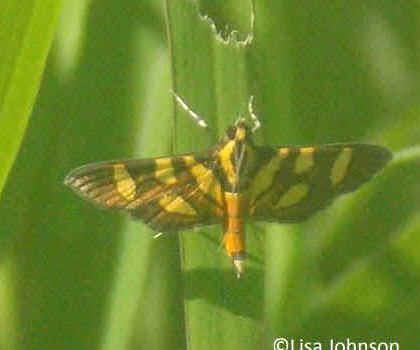
Orange-spotted Flower Moth
(copyrighted photo by Lisa Johnson)
- Terastia meticulosalis ______ BZ
- Trichaea pilicornis ______ BZ
- Triuncidia eupalusalis ______ BZ
Family PYRALIDAE,
Subfamily PYRALINAE (and including Subfamily CHRYSAUGINAE)
- Dolichomia amoenalis (phTM) ______
BZ HN occurs in Central America and in South
America in Venezuela and Surinam
A synonym for Dolichomia amoenalis
is Hypsopygia amoenalis.
- Dolichomia resectalis ______ BZ
- Galasa phillips (phTM)
______ HN (in subfamily CHRYSAUGINAE)
- Mapeta schausi ______ BZ
- Mapeta xanthomelas ______ BZ
- Zanclodes sp. (phTM)
______ HN
Family THYRIDIDAE:
PICTURE-WINGED LEAF MOTHS
has been included in the
PYRALOIDEA superfamily
Now THYRIDIDAE is the only family in the superfamily THYRIDOIDEA.
In 4 subfamilies, most of the species live in the tropics and subtropics.
Their biology is little known, and Thyridid specimens are rare in museum
collections.
- Pentina flammans ______ CR
(100BM:37-c)
Family HEDYLIDAE:
BUTTERFLY MOTHS (or AMERICAN MOTH-BUTTERFLIES)
The HEDYLIDAE is an extant
sister group of the butterfly sister families PAPILIONOIDES (the SWALLOWTAILS) and
HESPERIOIDES (the SKIPPERS).
They have previously been treated as a tribe of GEOMETRIDAE (below, in
this list).
They have also been thought to be an unrecognized group of butterflies, and
in 2005 a study actually placed them with the butterflies based upon
molecular data.
The 35 currently recognized species in HEDYLIDAE, all in the genus Macrosoma,
are entirely Neotropical, ranging from central Mexico south to southwestern
Brazil. They also occur in the Caribbean region in Jamaica, Cuba, and
Trinidad.
- Macrosoma albula ______ CR
(BMCR:86)
- Macrosoma amaculata ______ CR
(BMCR:86)
- Macrosoma bahiata ______ CR
HN pb (BMCR:86)
- Macrosoma cascaria ______ CR
HN pb (BMCR:86)
- Macrosoma conifera ______ CR
HN pb (BMCR:86)
- Macrosoma costilunata ______
CR (BMCR:87)
- Macrosoma heliconiaria ______ CR
(BMCR:87)
- Macrosoma hyacinthina ______
CR HN pb (BMCR:87)
- Macrosoma intermedia ______ CR
(BMCR:87)
- Macrosoma lucivittata ______ CR
HN (BMCR:87)
- Macrosoma muscerdata ______ CR
(BMCR:88)
- Macrosoma rubedinaria ______ CR
HN pb (BMCR:88)
- Macrosoma semiermis ______ CR
HN pb (BMCR:88)
- Macrosoma tipulata ______ CR
(BMCR:88)
Family CASTNIIDAE: GIANT BUTTERFLY MOTHS
Medium to large-sized
moths. The adults have diurnal habits.
There are about 150 species in the family, living in temperate or warm
environments, tropical and subtrapical.
Most are Neotropical. In Costa Rica, there are 12 species.
Species in this family of diurnal moths, in the genus Zegara,
are members of a color pattern mimicry system with the following butterflies:
Heliconius ismenius
Hypothyris euclesia, in ITHOMIINAE
Melinaea lilis (or ethra), in NYMPHAIDAE
Eresia mechanitis, in NYMPHAIDAE
and the Tiger Mimic-Whites, Dismorphia amphione and the Eunoe
Mimic-White, Dismorphia eunoe.
Other Zegara species are mimetic with regard to moths in
the genera Chetone and Dysschema, in ARCTIINAE.
The larvae of CASTNIIDAE are endophagous, that is they mine inside
the stems of their host plants or dig tunnels in the ground for feeding on
the roots.
- Amauta cacica ______ CR
(BMCR:23)
- Athis clitarcha ______ CR
(BMCR:23)
- Castniomera atymnius ______ CR
(BMCR:23)
Castniomera atymnius futilis ______ CR
(BMCR:23) (ICR:94)
- Castniomera drucei ______ CR
(BMCR:23,25c)
- Imara analibiae ______ CR
(BMCR:23)
- Divana diva ______ CR
(BMCR:24)
- Leucocastnia licus ______ CR
(BMCR:24)
- Xanthocastnia viryi ______ CR
(BMCR:24)
Xanthocastnia vityi intermedia ______ CR
(BMCR:24)
- Zegara carilla ______ CR
(BMCR:24)
- Zegara columbina ______ CR
(BMCR:24)
Family GEOMETRIDAE,
larvae are: LOOPERS,
INCHWORMS, SPANWORMS
Adult GEOMETER MOTHS are
from small to large, but mostly medium-sized.
They generally have elongated bodies with wide wings, and many are stout.
The GEOMETRIDAE is a cosmopolitan family and one of the three largest
among the LEPIDOPTERA. It is estimated that at least 21,000 species
have been described. About 1,500 species have been found in Costa
Rica.
Family GEOMETRIDAE, Subfamily ENNOMINAE
- Acrotomodes cautama ______ CR
(BMCR:193c)
- Acrotomodes chiriquensis ______
CR (BMCR:194)
- Acrotomodes mucia ______ CR
(BMCR:192co)
- Anisoperas atropunctaria ______
BZ
- Betulodes matharma ______ CR
(BMCR:194)
- Certima turmalis
______ CR (BMCR:194)
- Cimicodes albicosta ______ HN
pb
- Cyclomia disparlis ______ HN pb
- Cyclomia minuta ______ HN pb
- Dyschoroneura obsolescens
______ HN pb
- Epimecis detexta ______ HN pb
- Epimecis fraternaria ______ CR
HN (BMCR:194)
- Epimecis matronaria ______
HN
pb
- Epimecis patronaria ______ HN
- Epimecis subroraria ______ HN
pb
- Epimecis sp. ______ HN pb
- Erastria decrepitaria ______
BZ HN pb
- Euclysia columbipennis ______ BZ
- Euclysia dentifasciata ______ HN pb
- Euclysia sp. ______
HN pb
- Eusarca asteria ______ HN pb
- Eusarca crameraria ______ BZ
- Eusarca minucia ______ BZ
HN pb
- Eusarca nemoria ______ HN pb
- Eusarca trifilaria ______ BZ
- Eutomopepla vorda ______ BZ
- Glena agria ______ HN pb
(species described in 1967)
- Herbita lilacina ______ HN pb
- Hyalostenele lutescens ______ CR
(BMCR:194)
- Hymenomima camerata ______ HN
pb
- Hymenomima tharpoides ______ BZ
- Hymenomima sp. ______ HN pb
- Hymenomima sp. ______ HN pb
- Iridopsis aviceps ______ HN pb
- Iridopsis chalcea ______ BZ
- Iridopsis herse ______ CR
HN pb (BMCR:192co)
- Iridopsis pandarosos ______ HN
pb
- Iridopsis oberthuri ______ HN
pb
- Iridopsis validaria ______ BZ
HN pb
- Ischnopteris chavezi
______ CR
(BMCR:194)
- Leuciris fimbriaria (phTM) ______
BZ HN occurs from Mexico
to Peru and Brazil
MIMOSA PEARL
The turquoise eggs of Leuciris fimbriaria, or
the Mimosa Pearl, are laid in batches on Mimosa
pigra and related plants.
- Leucula abilinearia ______ HN
- Macaria accumulata ______ BZ
- Macaria aequiferaria ______ HN
- Macaria combusta ______ BZ
- Macaria ferina ______ HN pb
- Macaria festivata ______ BZ
- Macaria gambarina
______ BZ CR HN pb (BMCR:194)
- Macaria guapilaris ______
HN pb
- Macaria lydia ______ HN pb
- Macaria ostia (phTM) ______ BZ
HN
- Macaria regulata ______ BZ
HN pb
- Macaria subfulva ______
BZ HN pb
- Macaria sp. ______ HN pb
- Melanchroia chephise (ph)
______ M#6616 CR
HN
(BMCR:192c,194)
WHITE-TIPPED BLACK MOTH
(or SNOWBUSH SPANWORM)
Melanchroia chephise
ranges from Texas (and Florida) south to Paraguay.
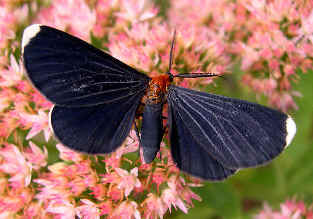
White-tipped Black Moth
- Melanolophia flexilinea ______
HN
- Melanolophia sadrina ______ HN
pb
- Melanolophia sp. ______ HN pb
- Microgonia rufaria ______ HN pb
- Nematocampa completa (phTM) ______
BZ HN pb
- Nematocampa sp. ______ HN pb
- Nepheloleuca floridata ______ HN
- Nepheloleuca politia ______ BZ
HN pb
- Nephodia organa
______ CR (BMCR:195)
- Nepitia detractaria
______ CR
(BMCR:195)
- Opisthoxia bella ______ HN
- Opisthoxia cluana ______
CR HN pb (BMCR:195)
- Opisthoxia elesiata ______
BZ
- Opisthoxia molpadia ______ CR
(BMCR:193c)
- Opisthoxia saturniaria ______
CR (BMCR:195)
Opisthoxia saturniaria compta ______ CR
(BMCR:195)
- Opisthoxia uncinata ______ HN
pb
- Oxydia apidania ______ HN pb
- Oxydia mexicana (phTM)
______ HN
- Oxydia sinuosa
______ CR occurs from Costa Rica to Peru
SINUOSA DEADLEAF
Some say that Oxydia
sinuosa is a subspecies of Oxydia
mexicana (above).
- Oxydia trychiata ______ CR
(BMCR:195)
- Oxydia versilinea ______
BZ
- Oxydia vesulia ______ BZ
HN pb
- Pantherodes pardalaria ______ HN
- Pantherodes unciaria ______ CR
(BMCR:196)
- Pantherodes sp. ______ HN pb
- Paragonia cruraria ______
BZ HN pb
- Parilexia cermala ______ HN pb
- Patalene aeneturaria ______ HN
pb
- Patalene asychisaria ______ BZ
HN pb
- Patalene hamulata ______ HN
- Patalene luciata ______ HN pb
- Patalene moneta ______
BZ
- Patalene trogonaria ______ BZ
HN pb
- Patalene sp. ______ HN pb
- Periclina syctaria ______ HN
- Perigramma guatemalaria ______ HNpb
- Perigramma repitita ______ HN
pb
- Pero afuera ______
HN pb
(species described in 1987)
- Pero amanda ______
BZ HN
- Pero anceta ______ HN pb
- Pero astapa ______ HN
- Pero aurunca ______ HN
- Pero chapela ______ BZ
CR (BMCR:195)
- Pero clysiaria ______ HN pb
- Pero coronata ______ HN pb
- Pero delauta ______
BZ HN
- Pero dularia ______
BZ HN
- Pero externa ______ BZ
- Pero fragila ______ HN
- Pero fusaria ______
HN
- Pero incisa ______ HN pb
- Pero lessema ______ HN
- Pero lignata ______ BZ
- Pero melissa ______ HN
- Pero plagodiata ______ BZ
CR
(BMCR:195)
- Pero polygonaria ______
BZ HN pb
- Pero probata ______
CR HN
pb (BMCR:195)
- Pero pumaria ______ HN pb
- Pero saturata ______ HN pb
- Pero spina ______ HN
- Pero stuposaria ______
BZ
- Pero rumina ______
BZ
- Pero verda ______ HN
- Phrygionis divitaria ______ HN
pb
- Phrygionis pallicosta ______
HN
pb
- Phrygionis platinata ______ BZ
Phrygionis platinata naevia ______ BZ
- Phrygionis polita ______ BZ
HN
- Phrygionis privignaria ______ BZ
HN pb
- Phyle schausaria ______ HN
- Phyllodonta angulosa ______ BZ
- Physocleora albibrunnea ______ BZ
- Physocleora taeniata ______ BZ
- Physocleora sp. ______ HN pb
- Pityeja histrionaria (ph) ______
CR HN (BMCR:196)

Pityeja histionaria
- Polla celeraria ______ BZ
HN pb
- Polla hemeraria (phTM) ______
CR HN (BMCR:196)
- Prochoerodes striata ______ HN
pb
- Prochoerodes sp. ______ HN
- Psamatodes abydata ______ HN pb
- Pyrinia itunaria ______ HN pb
- Pyrinia sanitaria ______
HN pb
- Pyrinia sp. ______ HN pb
- Rhomboptila brantsiata ______ BZ
- Rucana chaconi ______ CR
(BMCR:196)
- Sabulodes loba ______ BZ
- Sabulodes ornatissima ______ CR
(BMCR:196)
- Semiothisa agrammata ______ BZ
- Semiothisa arenisca ______ BZ
- Semiothisa carinaria ______
HN
pb
- Semiothisa divergentata ______
BZ HN pb
- Semiothisa gambaria ______ BZ
- Semiothisa salsa ______ BZ
CR
(BMCR:196)
- Sericoptera chiffa ______ CR
(BMCR:197)
- Sericoptera mahometaria ______ BZ
HN pb
- Simena luctifera ______ CR
HN
(BMCR:196)
- Simopteryx torquataria ______ CR
(BMCR:197)
- Sphacelodes vulneraria ______ M#6800
BZ CR HN pb
(BMCR:197)
- Stenalcidia sanguistellata
______ CR (BMCR:197)
- Stibaractis dioptis ______ CR
(BMCR:197)
- Synnomos firmamentaria ______ HN
- Thyrinteina arnobia ______ M#6772
BZ CR (BMCR:197)
- Thysanopyga abdominaria ______ BZ
- Thysanopyga amarantha ______ BZ
HN pb
- Thysanopyga apitruncaria ______
HN pb
- Thysanopyga carfinia ______ HN
pb
- Thysanopyga pygaria ______
HN
pb
- Tmetomorpha bitias ______ CR
(BMCR:197)
- Tornos pusillus ______ HN pb
(species described in 1954)
- Trotopera arrhapa ______ HN pb
- Trotopera olivifera ______ CR
(BMCR:197)
- Urepione quadrilineata
______ BZ
Family GEOMETRIDAE, Subfamily GEOMETRINAE
- Cathydata batina ______ CR
(BMCR:199)
Cathydata batina batina ______ CR
(BMCR:199)
- Chavarriella fallax ______ CR
(BMCR:199)
- Chloractis pulcherrima ______
CR (BMCR:199)
- Chlorochlamys sp. ______ HN
- Chloropteryx dealbata ______
HN
pb
- Chloropteryx diluta ______ HN
pb
- Chloropteryx opalaria ______ BZ
HN pb
- Chloropteryx sp. ______ HN
- Dichorda consequaria ______ HN
- Dichorda iris ______ CR
(BMCR:199)
- Hyalochlora antolodoxa ______ CR
(BMCR:199)
- Lissochlora manostigma (phTM) ______
BZ HN pb
- Lophochorista calliope ______
CR (BMCR:199)
- Neagathia coruptata ______ BZ
HN pb
- Nemoria astraea ______ CR
(BMCR:199)
- Nemoria aturia ______ HN
- Nemoria erina ______ CR
(BMCR:199)
- Nemoria karlae ______ HN pb
(species described in 1993)
- Nemoria ozalea ______ CR
(BMCR:200)
- Nemoria parcipunta ______
HN pb
- Nemoria priscillae ______ HN pb
(species described in 1993)
- Nemoria punctilinea ______ BZ
HN pb
- Nemoria scriptaria ______ HN pb
- Nemoria venezuelae ______ HN pb
- Nemoria vermiculata ______
CR (BMCR:200)
- Nemoria winniae ______ CR
(BMCR:200)
- Oospila albicoma ______ CR
(BMCR:200)
Oospila albicoma albicoma ______ CR
(BMCR:200)
- Oospila albipunctulata ______ CR
(BMCR:200)
- Oospila athena ______ CR
(BMCR:200)
- Oospila atopochlora ______ CR
(BMCR:201)
- Oospila concinna ______
HN pb
- Oospila depressa ______ BZ
- Oospila rosipara ______ HN pb
- Oospila tricamerata ______
BZ
- Oospila venezuelata (ph) ______
BZ CR HN pb (BMCR:201)
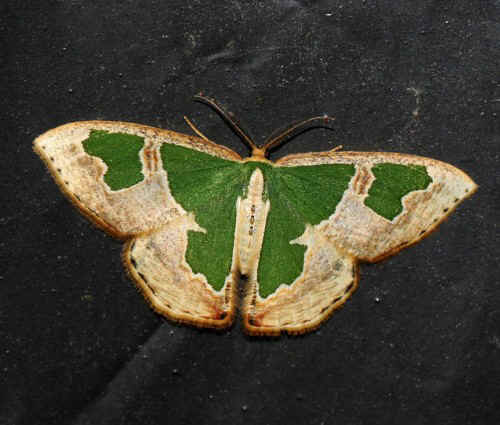
Oospila venezuelata
- Phrudocenta janeira ______
BZ CR HN pb (BMCR:201)
Phrudocenta janeira tenuis ______ CR
(BMCR:201)
- Phrudocenta pupillata ______ HN
pb
- Pyrochlora rhanis ______ BZ
CR HN pb
(BMCR:201)
- Rhodochlora brunneipalpis
______ CR HN pb
(BMCR:201)
Rhodochiora brunneipalpis minor ______ CR
(BMCR:201)
- Rhodochlora exquisita ______
CR (BMCR:201)
- Rhodochlora rothschildi ______ CR
(BMCR:201)
- Synchlora acuta ______ BZ
- Synchlora albisparsa ______ BZ
- Synchlora expulsata (phTM) ______ BZ
HN pb
- Synchlora gerularia ______ BZ
HN pb
- Synchlora pulchrifimbria ______
HN pb
- Synchlora superaddita ______ BZ
- Synchlora venustula ______ HN
pb
- Tachychlora amilletes ______
CR (BMCR:201)
- Tachyphyle acuta ______ HN pb
- Tachyphyle basiplaga
______ BZ
- Xerochlora masonaria ______ HN
pb
Family GEOMETRIDAE, Subfamily LARENTIINAE
- Crocypus perlucidaria ______ CR
(BMCR:205)
Crocypus periucidaria macroleuca ______ CR
(BMCR:205)
- Disclisioprocta stellata ______
HN pb
- Dyspteris deminutaria ______ BZ
- Dyspteris tenuivitta ______ CR
(BMCR:205)
- Eois binaria ______
HN pb
- Eois catana ______
HN pb
- Eois dorisaria ______ HN pb
- Eois expressaria ______ HN
- Eois heliadaria ______
HN
- Eois insignata ______ HN pb
- Eois isographata ______ CR
(BMCR:205)
- Eois numida ______ CR
(BMCR:205)
- Eois ungulata ______ CR
(BMCR:205)
- Eois sp. ______ HN pb
- Erateina rogersi ______ CR
(BMCR:205)
- Erateina staudingeri (ph) ______
CR (BMCR:205)
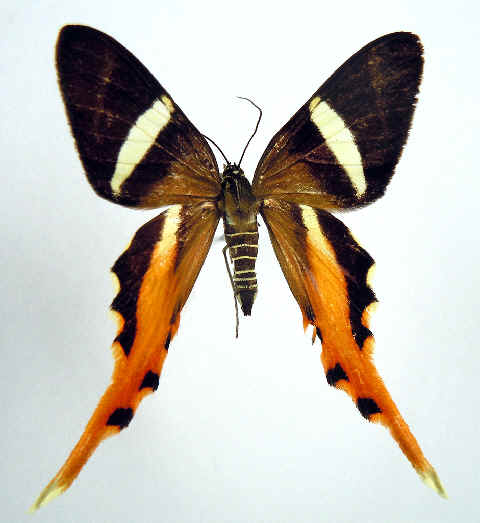
Above & below: Erateina staudingeri
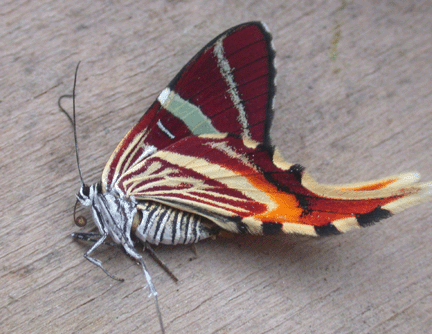
- Erebochlora tesserulata ______
CR (BMCR:205)
- Ersephila electa ______ CR (BMCR:206)
- Eubaphe deceptata ______ BZ
- Eubaphe conformis ______ HN pb
- Eubaphe sp. ______
HN sp
- Eudulophasia invaria ______ HN
pb
- Euphyia albipennis ______
BZ
- Euphyia cinerascens ______ HN
pb
- Euphyia subguttaria ______ CR
(BMCR:206)
- Euphyia sp. ______ HN pb
- Eupithecia spilosata ______ HN
- Eupithecia sp. ______ HN pb
- Eupithecia sp. ______ HN pb
- Eutrepsia dispar ______ HN
- Eutrepsia tortricina ______ CR
(BMCR:206)
- Graphidipus abraxaria ______
CR (BMCR:206)
- Hagnagora anicata ______ CR
(BMCR:206)
- Hagnagora clustimena ______ CR
(BMCR:206)
- Hagnagora ephestris ______ CR
(BMCR:207)
- Hagnagora mortipax ______ CR (BMCR:192c)
- Heterusia dividata ______ CR
(BMCR:207)
- Hydriomena polyphonta ______ CR
(BMCR:207)
- Obila floccosaria ______
BZ HN
- Obila pannosata ______ HN
- Obila sp. ______ HN pb
- Oligopluera aulaeata ______ HN
pb
- Oligopluera malaclitaria ______
HN pb
- Priapodes longipalpata ______ CR
(BMCR:207)
- Psaliodes sp. ______ HN pb
- Pseudomennis bipennis ______ CR
(BMCR:207)
- Pseudomennis dioptoides ______
CR (BMCR:207)
- Rheumaptera sp. ______
HN pb
- Spargania daphne ______ CR
(BMCR:207)
- Trocherateina specularia ______
CR (BMCR:207)
Family GEOMETRIDAE, Subfamily OENOCHROMINAE
- Ametris nitocris ______
CR HN pb (BMCR:198)
- Ergavia carinenta ______ CR
HN (BMCR:198)
- Ergavia merops ______ CR
HN pb (BMCR:198)
- Macrotes commatica ______ CR
HN pb
(BMCR:198)
- Racasta spatiaria ______ CR
(BMCR:198)
Racasta spatiaria caberaria ______ CR
(BMCR:198)
Family GEOMETRIDAE, Subfamily STERRHINAE
The WAVES are
almost all small to very small, often with characteristic patterns of
shingled "waves" radiating out from wing-base to
apex.
- Atyria commoda ______ CR
(BMCR:202)
- Atyria vespertina ______ CR
(BMCR:202)
- Atryriodes jalapae ______ CR
(BMCR:202)
- Cyclophora anablemma ______ HN
pb
- Cyclophora gigantula ______ CR
(BMCR:202)
Cyclophora gigantula cratoscia ______ CR
(BMCR:202)
- Cyclophora insigniata ______ CR
(BMCR:202)
- Cyclophora melitia ______
CR (BMCR:202)
Cyclophora melitia melitia ______ CR (BMCR:202)
- Cyclophora nodigera ______ CR
(BMCR:202)
- Cyclophora prunelliaria ______
CR (BMCR:202)
- Dithecodes distracta ______ HN
pb
- Dithecodes sp. ______ HN pb
- Haemalea imitans ______
HN pb
- Idaea complexaria ______ BZ
HN pb
- Idaea contractalis ______ HN
- Idaea elegentaria ______ HN pb
- Idaea helleria ______
BZ HN pb
- Idaea latiferaria ______ HN
- Idaea pervertipennis ______
HN
pb
- Idaea prusias ______ BZ
- Idaea spernata ______ HN
- Idaea subfervens (phTM) ______
CR HN pb (BMCR:203)
- Idaea tacturata ______ HN pb
- Idaea sp. ______ HN pb
- Leptostales angulata ______ CR
(BMCR:203)
- Leptostales crossii ______ HN
pb
- Leptostales sp. ______ HN pb
- Lobocleta figurinata ______ HN
- Pleuroprucha ochrea ______ HN
pb
- Pseudasellodes fenestraria ______
BZ CR (BMCR:203)
- Scopula apparitaria ______ HN
- Scopula confertaria ______ HN
- Scopula privata ______
HN pb
- Scopula subquadrata ______ HN
- Scopula suffundaria ______ HN
- Scopula umbilicata ______ HN
- Scopula sp. ______ HN pb
- Semaeopus caecaria ______ HN pb
- Semaeopus deflexa ______ HN
- Semaeopus illimitata ______
BZ CR (BMCR:203)
Semaeopus illimitata illimitata ______ CR
(BMCR:203)
- Semaeopus varia ______ BZ
CR HN pb (BMCR:203)
- Semaeopus sp. ______ HN pb
- Smicropus intercepta ______ CR
HN
(BMCR:193c,204)
- Smicropus laeta (ph) ______
CR HN pb (BMCR:204)
Smicropus laeta laeta ______ CR
(BMCR:204)

Smicropus laeta
- Tricentra fulvifera ______ HN
pb
- Tricentra ignefumosa ______ BZ
- Tricentra quadrigata ______ HN
pb
- Tricentra sp. ______ HN pb
- Tricentra sp. ______
HN pb
- Tricentrogyna deportata ______ HN pb
- Tricentrogyna violescens ______
HN pb
- Tricentrogyna sp. ______ HN pb
- Tricentrogyna sp. ______ HN pb
- Trygodes amphion ______ CR
(BMCR:204)
- Trygodes musivaria ______ BZ
CR HN pb (BMCR:204)
- Trygodes niobe ______ CR
(BMCR:204)
Trygodes niobe niobe ______ CR
(BMCR:204)
Family
SATURNIIDAE, Subfamily ARSENURINAE
SATURNIIDAE
has a wide distribution throughout the world, but especially in the
Neotropics.
Worldwide, about 1,480 species are known in 165 genera. 118 species have
been found in Costa Rica.
Adult moths in SATURNIIDAE do not feed.
- Arsenura archianassa ______ CR
(BMCR:46)
- Arsenura armida ______ CR
HN pb
(BMCR:46,49c) (100C:18-c) occurs in Central America and South
America
Arsenura armida
is unambiguously aposematic. Not to be found singly, but rather from
10 to 50 of the
cigar-sized caterpillars of this species cluster together in a patch on a
bare tree trunk.
They are fully exposed to every passing vertebrate predator, but they are
not preyed upon.
Not even the thousands of species of insects that prey on caterpillars
attack them.
- Arsenura batesii ______ CR
HN
(BMCR:46,50c) (100C:42-c)
Arsenura batesii arcaei ______ CR
(BMCR:46,50c)
- Arsenura drucei ______ CR
(BMCR:46) (100BM:43-c)
- Arsenura sylla ______ CR
(BMCR:46)
- Caio championi ______ CR
HN MX (BMCR:47,50c) (100C:93-c) occurs in Mexico, Central
America
A food plant for caterpillar of Caio
championi is a vulnerable tree in tropical dry forest Bombacopsis
quinata, in the family BOMBACACEAE.
That tree, often logged out of the forest, is known as
Pochote.
- Caio richardsoni ______ MX
occurs in Mexico
- Copiopteryx semiramis ______ CR
HN MX
(BMCR:47) (100C:41-c)
Copiopteryx semiramis banghaasi ______ HN
Copiopteryx semiramis occurs from Mexico to South America.
A host plant for Copiopteryx semiramis
is the tree Manilkara chicle in
the family Sapotaceae. (See note below in this list with Othoorene
purpurascens.)
- Dysdaemonia boreas ______ CR
HN pb
(BMCR:48) occurs in tropical America
- Paradaemonia platydesmia ______
CR (BMCR:48)
- Rhescyntis hippodamia (phTM) ______ CR
HN
(BMCR:48,50c) (ICR:96) (100BM:93-c)
- Titaea tamerlan ______
CR HN pb
(BMCR:48,49c)
Titaea tamerian nobilis ______ HN
Family SATURNIIDAE, Subfamily CERATOCAMPINAE
- Adeloneivaia boisduvalii ______
CR HN pb (BMCR:51)
- Adeloneivaia isara ______ CR (BMCR:51)
- Adeloneivaia jason ______ CR
HN pb (BMCR:51,56c) (100V:39-c) occurs in Central America and South
America
- Adeloneivaia subangulata ______
CR HN (BMCR:51)
- Adelowalkeria caeca ______ HN
pb (species described in 1969)
- Citioica anthanilis ______ HN
- Citheronia azteca ______ MX
occurs in Mexico, Guatemala
- Citheronia bellavista ______ CR
HN (BMCR:52) occurs Central America and northern
South America
- Citheronia collaris ______ CR
- Citheronia lobesis ______ CR
HN (BMCR:52) (100C:9-c)
Citheronia lobesis jordani ______ MX
subspecies in Mexico, Guatemala
Citheronia lobesis is a
tropical dry-forest relative of the North American Citheronia
regalis, the Regal Moth
- Citheronia pseudomexicana
______ MX occurs in
Mexico
- Citheronia splendens ______ M#7707
MX
Citheronia splendens sinaloenis ______ MX
Cithronia splendens sinaloenis occurs in
Mexico.
- Citheronia volcan ______ CR
(BMCR:51)
- Citheronioides collaris ______ CR
HN pb (BMCR:52)
- Citioica anthonilis ______ CR
(BMCR:52) occurs in Central America and South
America
- Eacles imperialis (ph)
______ M#7704 BZ
CR HN pb (BMCR:53) (ICR:97) (100C:14-c)
Eacles imperialis decoris ______ HN
IMPERIAL MOTH
With current taxonomy, Eacles imperialis is
the New World saturniid with the largest geographic range, occurring
from Ontario in Canada south to Argentina.
It has a number of relatives in the tropics.
In Costa Rica, Eacles imperialis
is found throughout all lowland habitats, from the very driest to the very
wettest. It is the only Eacles
species in that country in dry forest.
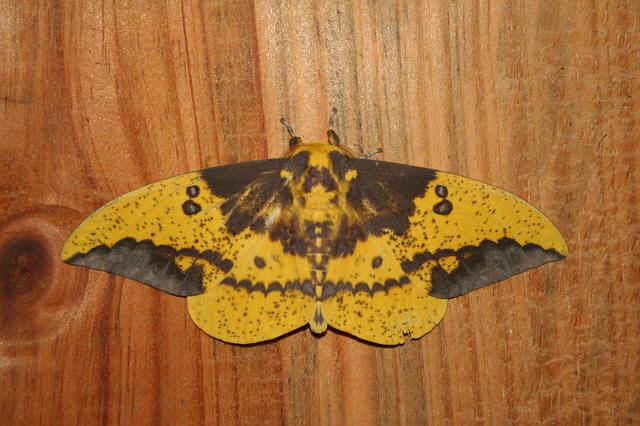
An Imperial Moth photographed in Central
America
- Eacles masoni ______ CR
HN
(BMCR:53) occurs in Central America and South America.
In Costa Rica, Eacles masoni
is in rain forest and lower cloud
forest.
- Eacles ormondei ______ BZ
CR HN pb
(BMCR:53) (ICR:96)
ORMONDEI IMPERIAL MOTH
In Costa Rica, Eacles ormondei is
in rain forest and lower cloud forest.
- Eacles penelope ______
CR
In Costa Rica, Eacles penelope is
in rain forest and lower cloud forest.
- Othorene purpurascens ______ CR
HN (BMCR:53,56c)
(100C:15-c)
A host plant for Othorene
purpurascens is the sapotaceous tree Manilkara
chicle, the Chicle from which the latex used in making
chewing gum is obtained.
As the caterpillar of Othorene purpurascens
starts to eat a Manilkara chicle leaf,
it cuts the leave halfway through its base, and sometimes at other places,
to avoid getting a face full of white latex with each bite. With the leaf's
latex-vessel network cut off from that of the remainder of the tree, the
defensive latex, a crude liquid rubber, is just another potential food in
the leaf being snipped into pieces and swallowed by the caterpillar.
The tree Manilkara chicle occurs
only in dry forest.
Another host plant, in cloud forest, for Othorene
purpurascens, is Pouteria
exfoliata. And yet another host plant can be Chryosphyllum
brenesii.
- Othorene verana ______ CR
HN
MX
(BMCR:54) (100BM:38-c) occurs in Mexico and Central America.
- Ptiloscola dargei ______ CR (BMCR:54)
- Schausiella denhezorum ______
CR (BMCR:54)
- Schausiella moinieri ______ CR
(BMCR:54)
- Schausiella santarosensis
______ CR HN pb (BMCR:54)
(100C:40-c)
- Syssphinx colla ______ CR
HN
MX (BMCR:55,56c) occurs in Mexico, Guatemala.
- Syssphinx mexicana ______ CR
HN (BMCR:55)
(100C:67-c)
- Syssphinx molina ______ CR
HN pb (BMCR:55) (100C:95-c) occurs from Mexico to Argentina.
- Syssphinx montana ______ HN pb
- Syssphinx quadrilineata ______ CR
HN pb (BMCR:55) (100C:16-c) occurs in in Mexico and Central America.
- Syssphinx sp. ______ HN pb
Family SATURNIIDAE, Subfamily HEMILEUCINAE
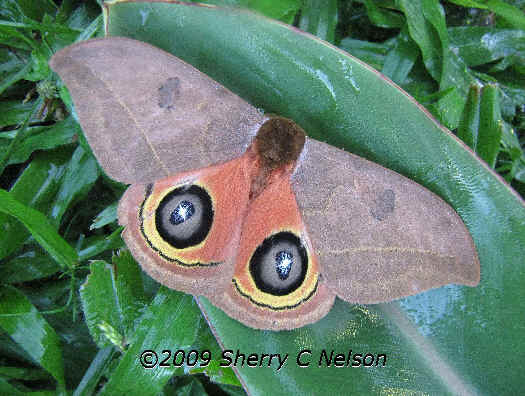
Photographed in
Guatemala, an Automeris moth
in the family Saturniidae
(photo by Sherry Nelson)
- Arias inbio ______ CR
(BMCR:57)
- Automeris banus ______ BZ
CR HN
(BMCR:57) (ICR:99) occurs in Central America and northern South
America
- Automeris belti (ph) (phTM) ______ BZ
CR HN pb
(BMCR:57,70c) (100BM:3-c)
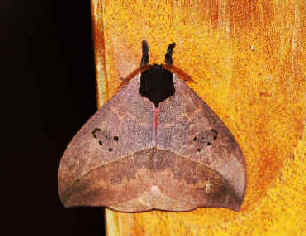
Automeris belti, photographed during a FONT tour
(photo by Marie Gardner)
- Automeris celata ______ CR
(BMCR:57)
- Automeris duchartrei ______ CR
(BMCR:57)
- Automeris excreta ______ HN
- Automeris exigua ______ CR
(BMCR:57)
- Automeris fieldi ______
CR (BMCR:60)
- Automeris gabriellae ______ BZ
- Automeris hamata ______ BZ
CR HN
(BMCR:58)
- Automeris io (ph) ______ M#7746
BZ
CR
(BMCR:58,70c) (100BM:4-c)
IO MOTH
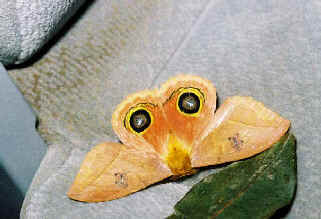
An Io Moth photographed during a FONT tour
in Belize
- Automeris jucunda ______ HN
occurs in Central America and northern South
America
- Automeris kopturae ______ CR
(BMCR:58)
- Automeris lauta ______ HN
occurs in Guatemala and Honduras (species described in 1948).
- Automeris macphaili ______
occurs in Mexico, Guatemala.
- Automeris metzli ______ BZ
CR HN
(BMCR:58,59) (100BM:85-c) occurs from Mexico to Venezuela, and in Colombia,
Ecuador
- Automeris moloneyi ______ BZ
HN
- Automeris montezuma ______ BZ
occurs in Mexico, Guatemala
- Automeris oaxacensis ______ MX
occurs in Mexico
- Automeris pallidior ______ CR
HN (BMCR:59)
- Automeris phrynon ______ CR
HN (BMCR:59) (100BM:86-c)
- Automeris postalbula ______ CR
HN
(BMCR:59) (ICR:101) (100C:1-c)
- Automeris rubrescens ______ HN
- Automeris tridens ______ CR
HN
MX (BMCR:60,69c) (100C:2-c) occurs in eastern Mexico and Central
America
- Automeris zozine (phTM) ______
BZ HN pb MX occurs in Mexico, Guatemala,
Honduras
- Automeris zugana ______ CR
(BMCR:60) (ICR:100) (100C:3-c)
- Automeris zurobara ______ CR
(BMCR:60)
- Cerodirphia avenata ______ CR
(BMCR:60)
- Dirphia avia ______ CR
HN pb
(BMCR:61,70c) (100C:4-c) occurs in Central America and South
America
- Dirphia horcana ______ CR
(BMCR:61)
- Dirphia panamensis ______
occurs in Central America and northern South America
- Dirphiopsis flora ______ CR
HN
(BMCR:61,69eggs) occurs from Honduras to
Bolivia
- Dirphiopsis wolfei ______ MX
occurs in southern Mexico and Guatemala
- Gamelia abas ______ HN pb
- Gamelia musta ______ CR
(BMCR:61,70c) (100C:92-c)
- Gamelia septenrionalis ______ CR
HN (BMCR:61,62)
- Hylesia aeneides ______ CR
(BMCR:62)
- Hylesia annulata ______ CR
(BMCR:62)
- Hylesia bertrandi ______ CR
(BMCR:64)
- Hylesia continua ______ CR
HN pb (BMCR:62)
- Hylesia dalina ______ CR
(BMCR:62)
- Hylesia frigada ______ CR
(BMCR:63)
- Hylesia gamelioides ______
HN
- Hylesia gigantex ______ CR
(BMCR:63)
- Hylesia hamata ______ CR
(BMCR:63)
- Hylesia invidiosa ______ CR
(BMCR:63)
- Hylesia iola ______ MX
occurs in southwestern Mexico
- Hylesia lineata ______ BZ
CR HN pb
(BMCR:63) (100C:26-c)
- Hylesia rosacea ______ CR
HN pb
(BMCR:63)
Hylesia rosacea rosacea ______ HN
pb
- Hylesia rubrifrons ______ CR
HN pb (BMCR:64)
- Hylesia rufipes ______ CR
(BMCR:64)
- Hylesia tinturex ______
HN
- Hylesia umbrata ______ CR
(BMCR:64)
- Hylesia umbratula ______ HN
- Hyperchiria nausica (phTM) ______ BZ
CR HN pb
(BMCR:64) occurs from Mexico to South America
- Leucanella acutissima ______ BZ
CR HN
(BMCR:65)
- Leucanella contempta ______ HN
(species described in 1967)
- Leucanella hosmera ______ CR
(BMCR:65) (100C:10-c) occurs in Costa Rica
- Leucanella leucane ______ BZ
- Leucanella saturata ______ MX
Leucanella saturata
occurs in Mexico.
- Lonomia columbiana ______ CR
(BMCR:65)
- Lonomia electra ______ M#7750.99
BZ
CR HN pb MX
(BMCR:65) occurs from southern Mexico through Central America to
Panama
- Lonomia rufescens (phTM) ______
CR HN (BMCR:66)
- Molippa nibasa ______ BZ
CR HN (BMCR:66,70c) occurs in tropical
America
- Molippa ninfa ______ BZ
MX occurs in Mexico and Central America
- Molippa simillima ______ CR
(BMCR:66)
- Molippa tusina ______ CR
(BMCR:66)
- Paradirphia boudinoti ______ HN
(species described in 1990)
- Paradirphia citrina
______ occurs in Guatemala
- Paradirphia hoegei ______ MX
occurs in southeast Mexico, Guatemala
- Paradirphia lasiocampina ______
MX occurs in western Mexico
- Paradirphia rectilineata ______
HN (species described in 1994)
- Paradirphia semirosea ______ CR
HN (BMCR:67)
- Paradirphia valverdei ______
MX occurs in Mexico, Guatemala
- Paradirphia winnifredae ______ CR
(BMCR:67)
- Periga cluacina ______ CR
(BMCR:67)
- Periphoba arcaei ______ CR
HN pb MX
(BMCR:67,70c) (100C:88-c) occurs from Mexico to Costa Rica
- Pseudautomeris irene ______ CR
(BMCR:68)
- Pseudodirphia lacsa ______ CR
(BMCR:68)
- Pseudodirphia menander ______ CR
HN (BMCR:68) (ICR:102) (100BM:90-c)
- Pseudodirphia mexicana ______ MX
occurs in southern Mexico
- Pseudodirphia regia ______ CR
HN
(BMCR:68) occurs in Central America and northwest South
America
- Xanthodirphia abbreviata ______
CR (BMCR:68)
- Xanthodirphia amarilla ______ CR
(BMCR:68)
Family SATURNIIDAE, Subfamily SATURNIINAE
- Antheraea godmani ______ BZ
CR HN (BMCR:71) (ICR:105) occurs from Mexico to Colombia.
- Copaxa copaxoides ______ MX
occurs in southwest Mexico.
- Copaxa curvilinea ______ CR
HN
(BMCR:71) (100BM:48-c) occurs in Nicaragua, Costa Rica.
- Copaxa cydippe ______ HN
MX occurs from Mexico to Honduras.
- Copaxa denda ______ MX
occurs in Mexico
- Copaxa escalantei ______ BZ
CR HN (BMCR:72) occurs from Mexico to
Panama (species described in 1971)
- Copaxa evelynae ______ HN
occurs in Guatemala, Honduras. (species described in 1993)
- Copaxa lavendera ______ HN
MX occurs from Mexico to Honduras
- Copaxa mannana ______ MX
occurs in Mexico
- Copaxa mazaorum ______ HN
MX occurs in Mexico (species described
in 1982)
- Copaxa moinieri ______ CR
(BMCR:71,75c,eggs)
occurs in Costa Rica
- Copaxa multifenestrata ______ BZ
CR HN pb (BMCR:72)
- Copaxa rufa ______ MX
occurs in southwest Mexico
- Copaxa rufinans ______ BZ CR
HN pb
(BMCR:72eggs) (ICR:106)
(100C:87-c)
Caterpillars of Copaxa rufinans
feed on plants in the LAURACEAE
family.
- Copaxa simson ______ CR
(BMCR:72) occurs in Central America and South America
- Copaxa sophronia ______ HN
MX occurs from Mexico to Honduras
- Copaxa syntheratoides ______ CR
(BMCR:73) (ICR:107)
- Copaxa troetschi ______ CR
(BMCR:73)
- Copaxa trotterorum ______ CR
(BMCR:73)
- Eupackardia calleta ______ H#7763
HN MX occurs from the southern US and Mexico to Honduras.
Caterpillars of the species of ROTHSCHILDIA
(below) spin dense, bag-like pendent silk cocoons, with a complex
exit made at the top and a long silk extension firmly binding the cocoon to
a twig.
These cocoons are generally spun down low in the relatively
"monkey-safe" and "large bird-safe" zone of 3 to 6 feet
above the ground, even if the caterpillars were to do their feeding much
higher above in the canopy, which is where Rothschildia
caterpillars are normally found.
- Rothschildia erycina ______ BZ
CR HN MX (BMCR:74) (100BM:94-c)
Rothschildia erycina mexicana ______ HN
Rothschildia erycina nigrescens ______ CR
subspecies from
Costa Rica to Ecuador
Rothschildia erycina
occurs from Mexico to Paraguay.
- Rothschildia lebeau ______ M#7761.1
BZ
CR HN pb MX (BMCR:74,75c) (ICR:103)
(100C:82-c)
Rothschildia lebeau forbesi ______ MX
subspecies in Texas,
Mexico
LEBEAU'S SILKMOTH
- Rothschildia orizaba (ph) ______
H#7762 CR HN MX PN (BMCR:73,74)
Rothschildia orizaba orizaba ______ subspecies in Mexico and
Central America
ORIZABA SILKMOTH
(another name is Window-winged Saturnian)
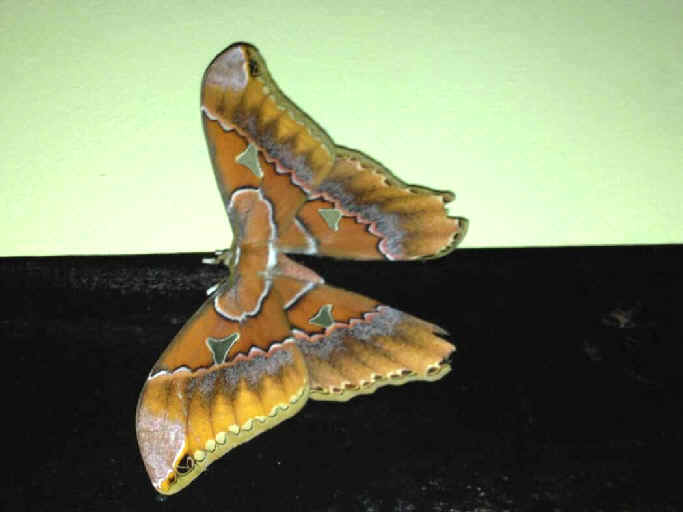
Above and below: Orizaba Silkmoths
Above, photographed in October 2012 in
Boquete, Panama
(photo by Francisco Crespo)
Below, a photograph in Guatemala showing the size
(photo by Sherry Nelson)
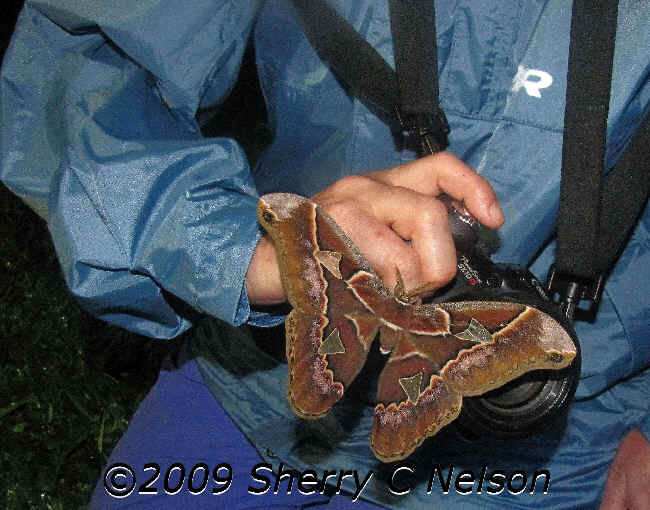
- Rothschildia roxana ______
BZ HN pb MX occurs in Mexico, Belize, Guatemala
- Rothschildia triloba ______
CR (BMCR:74,75c) (ICR:104) (100C:23-c)
occurs in Central
America
Family SATURNIIDAE, Subfamily OXYTENINAE
- Oxytenis albiunulata ______ CR
(BMCR:76)
- Oxytenis beprea ______ CR
HN pb
(BMCR:76)
- Oxytenis ferruginea ______ CR (BMCR:77)
- Oxytenis gigantea ______ CR (BMCR:76)
- Oxytenis modestia ______ CR
HN pb
PN (BMCR:77) (ICR:95-c) (100BM:47-c)
"DEAD-LEAF" MOTH
- Oxytenis naemia ______ CR
PN (BMCR:77)
Oxytenis naemia orecta ______ CR PN (BMCR:77)
- Oxytenis nubila ______
CR (BMCR:77)
- Therinia transversaria (ph) ______ CR
(BMCR:76) (ICR:108) (formerly Asthenidia
transversaria)
Therinia transversaria salax ______ CR
(BMCR:76)
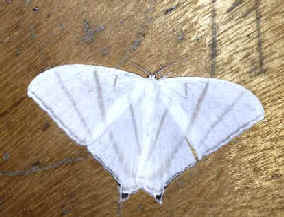
Therinia transversaria photographed during a FONT
tour
(photo by Fred Lesser, taken after dark on his
i-phone)
Family SPHINGIDAE: SPHINX
MOTHS, including HAWK MOTHS or "HUMMINGBIRD MOTHS''
SPHINGIDAE is distributed throughout
the world, and is well represented in the tropics.
Worldwide, there are about 1,200 species in 200 genera. About 145 species
have been found in Costa Rica.
Moths in the family SPHINGIDAE are generally very strong flyers.
- Adhemarius daphne ______ CR
(BMCR:78) (in subfamily Smerinthinae)
Adhemarius daphne interrupta
occurs in Mexico and Central America.
Another subspecies, A. d. daphne, occurs widely in South America.
A. d. cubanus occurs in Cuba.
- Adhemarius dariensis ______ CR
HN (BMCR:78) (in subfamily Smerinthinae)
- Adhemarius donysa ______ HN
(in subfamily Smerinthinae)
- Adhemarius fulvescens ______
CR (BMCR:78) (in subfamily
Smerinthinae)
- Adhemarius gannascus ______
BZ CR HN pb (BMCR:78) (in subfamily
Smerinthinae)
Adhemarius gannascus gannascus ______ HN
pb
Adhemarius gannascus
is found from Mexico to extreme southeast Brazil.
- Adhemarius palmeri ______ CR
(BMCR:78) (in subfamily Smerinthinae)
Adhemarius palmeri
occurs in Costa Rica and Panama and widely across South America.
- Adhemarius ypsilon (phTM) ______
BZ CR HN (BMCR:78) (ICR:112)
(100BM:16) (in subfamily
Smerinthinae)
- Aellopos ceculus ______ BZ
CR HN pb (100BM:83-c)
(in subfamily Macroglossinae)
Aellopos ceculus is found widely
across the Neotropics.
- Aellopos clavipes ______ M#7848
BZ HN (in subfamily Macroglossinae)
CLAVIPES SPHINX MOTH
- Aellopos fadus ______ M#7850
CR
(BMCR:84co) (in subfamily
Macroglossinae)
FADAS SPHINX MOTH
Aellopos fadus occurs from
Mexico to Argentina. In the US, it has been found in Florida, Texas,
Arkansas, and Washington State.
- Aellopos tantalus (ph)
______ M#7847 CR (species
described by Linnaeus in 1758)
TANTALUS SPHINX MOTH (or
TANTALUS HUMMINGBIRD HAWKMOTH)
Aellopos tantalus is widely
distributed across South America.
Similar to a small hummingbird, Aellopos tantalus is a mostly
brown-winged moth with a conspicuous silvery white band on the dorsal surface of
its lower back. The moth hovers, like a hummingbird, with its wings a blur as it
probes for nectar with its long proboscis.
Aellopos tantalus is similar
Aellopos titan and Aellopos fadus,
but it is smaller and with only 3 white triangular marks in a line on the
forewing, and a 4th above the outermost mark.

Tantalus Sphinx Moth
- Aellopos titan ______
M#7849 BZ
CR HN (BMCR:81) (in subfamily
Macroglossinae)
TITAN SPHINX MOTH
Aellopos titan titan occurs in
Mexico, Central America, and across most of South America. That subspecies
is also in the West Indies. It is replaced in Cuba by A.
t. cubana.
The species is a strong flier, and has been found across the eastern United
States, and even into southern Canada. Breeding has been confirmed in the US
in Texas.
Overall, Aellopos titan is a
common species.
- Agrius cingulata (ph) ______
M#7771 BZ
CR HN pb (BMCR:79) (PNE:257)
(in subfamily SPHINGINAE)
PINK-SPOTTED HAWK MOTH
Agrius cingulata is primarily
Neotropical, but it also breeds in the southern USA, and strays have been
recorded as far north as eastern Canada and even in western
Europe.
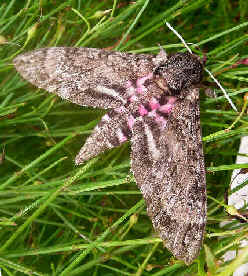
Pink-spotted Hawk Moth
- Aleuron carinatum ______ BZ
- Aleuron chloroptera ______ BZ
HN
Aleuron chloroptera
can be found throughout the Neotropical region.
- Aleuron iphis ______ BZ
Aleuron iphis
can be found across the Neotropics.
- Aleuron neglectum ______ BZ
CR HN (BMCR:81) (in subfamily
Macroglossinae)
Aleuron neglectum is a
Neotropical species with a similar range, characteristics and behavior as Aleuron
chloroptera and Aleuron iphis.
- Amphimoea walkeri ______ BZ
CR HN (BMCR:79) (in subfamily
Sphinginae)
DARWIN HAWKMOTH
Amphimoea walkeri occurs
widely in Central America and South America.
- Callionima denticulata ______ CR
HN pb
Callionima denticulata
occurs in Mexico, Central America, and in South America south to
Bolivia.
- Callionima falcifera ______ H#7845
BZ HN pb
FALCIFERA SPHINX MOTH
Callionima falcifera occurs
from Central America south to central South America.
- Callionima inuus ______ BZ
Callionima inuus
occurs throughout the Neotropics.
- Callionima nomius (phTM) ______ BZ
CR HN pb (BMCR:81) (in subfamily
Macroglossinae)
Callionima nomius is found
throughout the Neotropics.
- Callionima pan ______ HN
Callionima pan is found from
Central America south to Amazonia. It is replaced by C. p. neivai in
southern Brazil.
- Callionima parce ______ BZ
HN pb
Callionima parce occurs widely
from Mexico to Argentina.
- Cautethia spuria ______ M#7868
BZ
CR HN (BMCR81,85c)
(in subfamily Macroglossinae)
SPURIOUS SPHINX MOTH
- Cautethia yucatana ______
M#7869 BZ HN
- Cocytius antaeus ______
M#7772 BZ
CR HN (W:255)
GIANT SPHINX
Cocytius antaeus occurs
throughout the Neotropics. In the US. it occurs in Florida, Texas, Arizona,
Mississippi.
There are populations in the West Indies but no subspecies.
- Cocytius cluentius ______ BZ
- Cocytius duponchel ______
M#7773 BZ HN pb
DUPONCHEL'S SPHINX MOTH
Cocytius duponchel
ranges in Central America, and in northern and central South America. as
well as in the Antilles.
The taxonomy of Cocytius duponchel
may change to Amphonyx.
- Cocytius lucifer ______
BZ CR HN (BMCR:79) (100C:55-c) (in subfamily
Sphinginae)
Cocytius lucifer
ranges in Central America and in northern and central South America.
The taxonomy of Cocytius lucifer may
change to Amphonyx.
- Dolbogene igualana ______ CR
(BMCR:79) (in subfamily Sphinginae)
- Enyo cavifer ______ BZ
Enyo cavifer
is a Neotropical species, in Central America and south to
Brazil.
- Enyo gorgon ______ BZ
CR HN (BMCR:81) (in subfamily
Macroglossinae)
Enyo gorgon
is a Neotropical species, in Central America and in most of South America.
- Enyo japix ______ BZ
- Enyo lugubris (ph) ______
M#7851 BZ HN pb
(species described by Linnaeus in 1771)
MOURNFUL SPHINX MOTH
Enyo lugubris lugubris is widespread across Central
America and South America.
It is replaced by E. l. delanoi in
the Galapagos Islands.
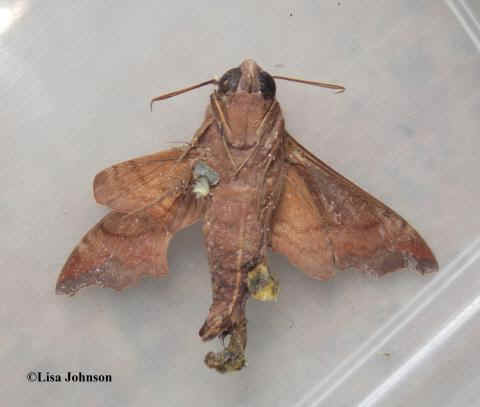
Mournful Sphinx Moth
(copyrighted photo by Lisa Johnson)
- Enyo ocypete (phTM) ______
M#7852 BZ CR HN pb
(100BM:84)
(species described by Linnaeus in 1758)
Enyo ocypete
is a widespread species occurring in most of the Neotropics.
- Enyo pronoe ______ BZ
- Enyo taedium (phTM)
______ HN pb
- Erinnyis alope ______ M#7832
BZ
CR HN pb (BMCR:81) (W:278) (in subfamily
Macroglossinae)
ALOPE SPHINX MOTH
Erinnyis alope alope
occurs from Caribbean islands and south through Central America and into
South America to northern Argentina. In occurs in various southern US
states, including Florida where it regularly breeds. Strays have
occurred as far north as Massachusetts in the US and Saskatchewan in Canada.
As with other Erinnyis species,
there is a separate subspecies in the Galapagos Islands, E.
a. dispersa.
- Erinnyis crameri ______
M#7836 BZ
CR HN
(BMCR:85co) (100C:37-c) (in subfamily Macroglossinae)
CRAMER'S SPHINX MOTH
Erinnyis crameri
occurs in the Neotropics from Mexico to Paraguay and southern Brazil, and
in the West Indies and in the southern states of the US.
- Erinnyis domingonis ______ BZ
- Erinnyis ello ______ M#7834
BZ
CR HN
(W:266) (100C:63-c) (species described by Linnaeus in 1758)
ELLO SPHINX MOTH
Erinnyis ello ello
occurs in the Neotropics as far south as northern Argentina. It also breeds
in some southern US states: Florida, Texas, Arizona, California.
The subspecies E. e. encantada is
found in the Galapagos Islands.
- Erinnyis lassauxi ______ M#7833
BZ HN
LASSAUX'S SPHINX MOTH
Erinnyis lassauxi occurs from
Mexico to northern Argentina. It is also found on some Caribbean islands,
and in the southern US in Texas and possibly Arizona and Florida.
- Erinnyis obscura ______
M#7837 BZ HN
OBSCURE SPHINX MOTH
Erinnyis obscura occurs from
Mexico to Argentina, and in the southern states of the US.
The subspecies E. o. conformis is
in the Galapagos Islands.
- Erinnyis oenotrus ______ M#7835
BZ HN pb
OLEANDER SPHINX MOTH
Erinnyis oenotrus
occurs from Mexico and the West Indies south to northern Argentina. The
species also strays into the southern US states of Florida and Texas.
- Erinnyis yucatana ______ M#7839.1
BZ HN
- Eumorpha achemon ______
M#7861 HN
(PNE:267) (in subfamily MACROGLOSSINAE)
ACHEMON SPHINX MOTH
- Eumorpha anchemolus ______ M#7857
BZ HN pb
Eumorpha anchemolus
occurs from southern Mexico to northern Argentina.
- Eumorpha capronneri ______ HN
- Eumorpha fasciatus ______ M#7865
BZ
CR HN pb (BMCR:81) (ICR:111)
(in subfamily
Macroglossinae)
BANDED SPHINX MOTH
Eumorpha fasciatus
occurs from Mexico to Argentina, and on Caribbean islands. It breeds in the
southern US in the Carolinas, Florida, and west along the Gulf of Mexico and
eastern Texas, and north to Missouri.
Adults migrate long distances in the late summer in the Northern Hemisphere
and have been found as far north as Nova Scotia, New Brunswick, and Ontario.
A second subspecies, E. f. tupaci,
is found only in the Galapagos
Islands.
- Eumorpha labruscae
(ph)
______ M#7866 BZ CR
HN (BMCR:84co)
(100C:83-c) (in subfamily Macroglossinae) (species
described by Linnaeus in 1758)
GAUDY SPHINX MOTH
Eumorpha labruscae is a widespread
species, ranging from Mexico to Argentina, and on Caribbean islands and also
in the Nearctic region, where it has occurred as far north as Michigan in
the US and Saskatchewan.
A second subspecies, E. l. yupanquii,
occurs in the Galapagos Islands.
Eumorpha labruscae can grow up to the size of a human hand. This migrating
moth is commonly found in the West Indies and in Central and South America. It
occasionally occurs in the United States and as far north as Canada.
It is known as the Gaudy Sphinx Moth due to its remarkable markings and
the amazing array of colors on its wings.
It has a combination of green, blue, red, and yellow on the wings which explains
the flamboyant common name.
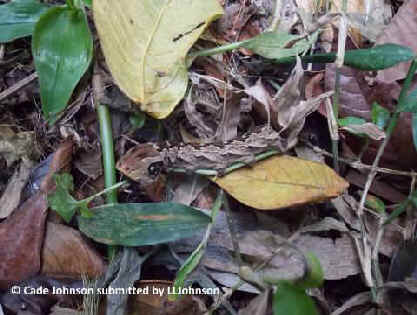
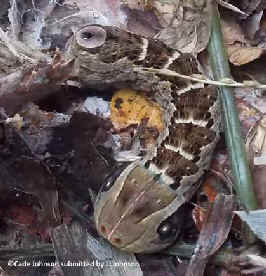
Above: two photographs of the caterpillar of the
Gaudy Sphinx Moth
(copyrighted photos by Cade Johnson)
Below: two photographs of the adult Gaudy Sphinx
Moth,
in the lower photo with the colorful wings open
(photos by Helene Kyrk)

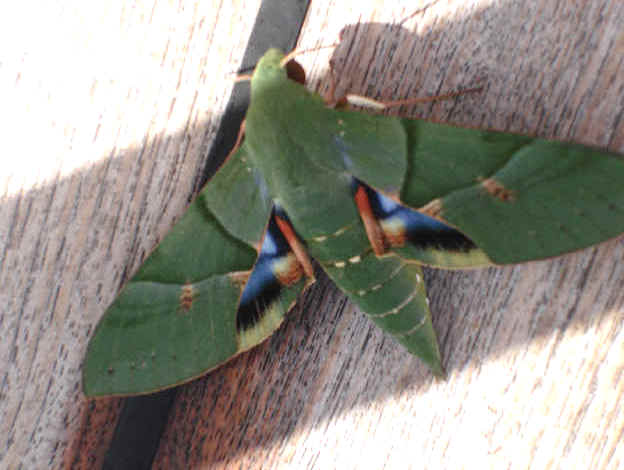
- Eumorpha megaeacus ______ M#7862
Eumorpha megaeacus occurs
from Mexico to Brazil.
- Eumorpha obliquus ______ BZ
HN
The nominate, Eumorpha obliqiuus obliquus,
occurs from Mexico to Bolivia. It is replaced in eastern Brazil by E.
o. orientis.
- Eumorpha phorbas ______
BZ HN pb
Eumorpha phorbas occurs from
Mexico to southern Brazil.
- Eumorpha satellitia (phTM) ______
M#7858 BZ CR HN pb
(100C:94-c) (species described by Linnaeus in 1771)
Eumorpha satellitia licaon ______ HN
pb
SATELLITE SPHINX MOTH
Eumorpha satellitia
is very common in the dry forest in northwest Costa Rica.
- Eumorpha triangulum ______ BZ
CR HN pb (BMCR:81) (in subfamily
Macroglossinae)
- Eumorpha typhon ______ HN
- Eumorpha vitis ______ M#7864
BZ
CR HN pb (species described by Linnaeus in 1758)
VINE SPHINX MOTH
Eumorpha vitis vitis ranges
from Mexico to Argentina. It also breeds in the US in southern Florida and
much of Texas.
Two subspecies occur on Caribbean islands. E. v.
fuscatus is on Saint Lucia, Guadeloupe, and Martinique.
E. v. hesperidum is on Jamaica.
- Eupyrrhoglossum sagra ______ M#7846.1
BZ
SAGRA SPHINX MOTH
Eupyrrhoglossum sagra
can be found across the Neotropics, including on Caribbean islands and
in Cuba. It has recently been found breeding in southern Florida.
- Hemeroplanes ornatus ______ BZ
CR HN pb (BMCR:82) (in subfamily
Macroglossinae)
Hemeroplanes ornatus occurs
widely from Mexico to southern Brazil.
- Hemeroplanes triptolemus ______
BZ CR HN (BMCR:82) (100C:53-c)
(in subfamily
Macroglossinae)
Hemeroplanes triptolemus
occurs widely from Mexico to Brazil.
- Hyles lineata (ph) ______
M#7894 CR HN (BMCR:82)
(PNE:269) (W:275) (in subfamily MACROGLOSSINAE) WHITE-LINED SPHINX MOTH
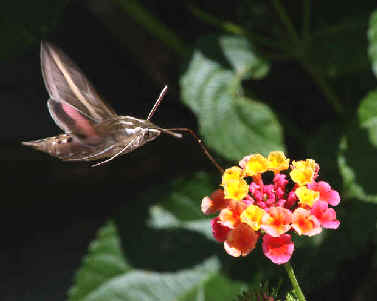
Above & below: Hyles
lineata, the White-lined Sphinx,
the moth and the caterpillar
Both photographs during a FONT tour.
(photos by Doris
Potter)
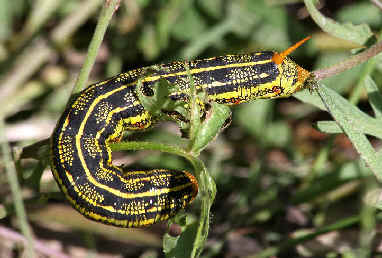
- Isognathus caricae ______
The nominate, Isognathus caricae caricae,
occurs from Mexico to southeast South America. A second subspecies, I.
c. rainermarxi,
was described in 1999 in Peru on the west side of the Andes
Mountains.
- Isognatus leachii ______
Isognatus leachii occurs from
Central America to Argentina.
- Isognathus rimosa ______ M#7831
BZ HN
- Isognathus scyron ______ BZ
CR HN (BMCR:82) (in subfamily
Macroglossinae)
- Isognathus swainsonii ______
Isognathus swainsonii
can be found from southern Central America to Brazil.
- Kloneus babayaga ______
CR (100BM:57-c)
Kloneus babayaga is a rare, or at
least a very rarely seen moth in Costa Rica. The species is similar to
another sphinx moth, Pachylia ficus (below, in this list).
To the suggestion that Kloneus babayaga
be merged into the Pachylia
genus, the coauthor of the master checklist of Sphingidae of the world (in
2000), Jean-Marie Cadiou, wrote:
"As to systematics, I strongly object to the prestigious Kloneus
being downgraded to the status of a mere
Pachylia ..... besides which the phrase 'Kloneus
babayaga' was coined by Skinner to mean 'son
of a bitch' in reference to Preston Clark, and it would be
a pity to lose that piece of entomological
history".
(source: "100 Butterflies and Moths, Portraits from the Tropical
Forests of Costa Rica", by Miller, Janzen, Hallwachs, 2007)
- Madoryx bubastus ______ BZ
(in subfamily Macroglossinae)
- Madoryx oictus ______
BZ HN (in subfamily Macroglossinae)
Madoryx oictus oictus occurs
widely from Mexico to southern Brazil. It is replaced in Jamaica by M. o.
jamicensis.
- Madoryx plutonius ______ BZ
CR HN pb (BMCR:82) (ICR:110) (100BM:58-c)
(in subfamily
Macroglossinae)
Madoryx plutonius ranges from
Costa Rica to Brazil. The nominate subspecies occurs In South America
whereas the subspecies in Central America is M. p.
dentatus.
- Manduca albiplaga ______ M#7779
BZ HN pb
Manduca albiplaga occurs from Mexico to northern Argentina.
- Manduca corallina ______ BZ
HN
- Manduca dilucida ______ BZ
CR
(BMCR:80co) (in subfamily Sphinginae)
- Manduca extrema ______
HN pb
- Manduca florestan (phTM) ______
M#7782 BZ
CR HN (BMCR:79,80c) (100C:96-c) (in subfamily
Sphinginae)
Manduca florestan occurs from
southeast Arizona and southwest New Mexico south through Central America to
northern Argentina.
- Manduca hannibal ______ BZ
Two subspecies of Manduca hannibal
occur from southern Central America south into Bolivia and Brazil.
M. h. hamilcar occurs in
northeast, southeast, and parts of southern Brazil.
M. h. mayeri occurs in
Mexico.
- Manduca incisa ______ HN
- Manduca lanuginosa ______ BZ
CR HN (BMCR:80co) (100C:72-c) (in subfamily Sphinginae)
- Manduca lefeburei ______ BZ
HN pb
The nominate Manduca lefeburei lefeburei
occurs widely across Central America and South America, while it is replaced
in Mexico by M. l. bossardi.
- Manduca lichenea ______ BZ
- Manduca muscosa ______
M#7781 BZ CR HN
(100C:29-c) (in subfamily
Sphinginae)
MUSCOSA SPHINX MOTH
- Manduca occulta ______
M#7777
BZ CR HN pb (BMCR:79) (in subfamily
Sphinginae)
OCCULT SPHINX MOTH
- Manduca ochus ______ BZ
HN pb
- Manduca pellenia ______ BZ
CR HN pb (100C:56-c)
- Manduca rustica (ph) ______
M#7778 BZ
CR HN pb (PNE:259) (W:249) (100C:30-c)
(in subfamily SPHINGINAE)
RUSTIC SPHINX MOTH
Manduca rustica rustica has a
broad distribution across South America, and further north in the West
Indies, Central America. and to the mid-Atlantic states of the
US.
Other subspecies are in: Mexico, Cuba, the Lesser Antilles, and the
Galapagos islands,
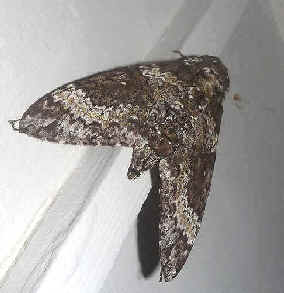
Rustic Sphinx Moth
- Manduca sexta (ph) ______
M#7775
BZ CR HN (PNE:257) (W:248)
(in subfamily SPHINGINAE) (species
described by Linnaeus in 1763)
CAROLINA SPHINX (TOBACCO HORNWORM)
Manduca sexta sexta occurs widely
across the USA and in Central America. It is replaced across much of South
America from Venezuela to Argentina by M. s.
paphus.
Other subspecies are in: Argentina, Chile, the Galapagos Islands, and
Jamaica, the Dominican Republic. and Saint
Lucia.
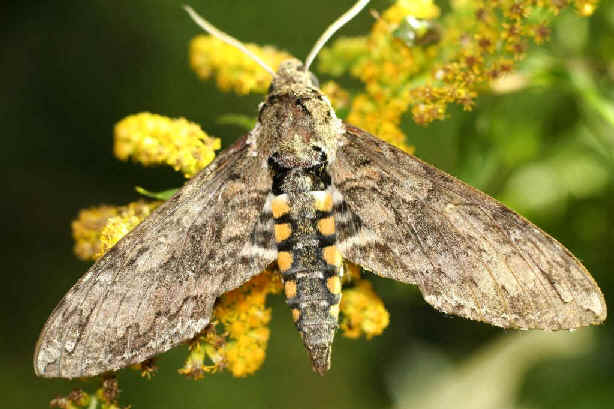
Carolina Sphinx
(photo by Stephen Kloiber)
- Manduca wellingi ______ BZ
HN (species described in 1984)
- Neococytius cluentius ______ M#7774
CR HN pb
(BMCR:79) (in subfamily Sphinginae)
Neococytius cluentius
occurs throughout Central America, and in most of South America, as well as
in the West Indies and Cuba. It occasionally strays into the USA as far
north as Michigan.
- Nyceryx coffaeae ______ BZ
CR HN
(BMCR:85co) (in subfamily Macroglossinae)
Nyceryx coffaeae
occurs widely in the Neotropics.
- Nyceryx eximia ______ HN
(in subfamily Macroglossinae)
- Nyceryx magna ______ CR
(100C:80-c) (in subfamily Macroglossinae)
- Nyceryx riscus ______ BZ
HN (in subfamily Macroglossinae)
Nyceryx riscus occurs from Mexico
to Argentina.
- Nyceryx tacita ______
CR HN (BMCR:82) (100C:38-c) (in subfamily
Macroglossinae)
- Oryba achemenides ______ BZ
CR (100BM:5) (in
subfamily Macroglossinae)
- Oryba kadeni ______ BZ
CR
(BMCR:82) (100BM:6-c) (in subfamily
Macroglossinae)
Oryba kadeni has been reported
from Central America south to southern Brazil.
- Pachygonidia caliginosa ______ BZ
- Pachygonidia drucei ______ BZ
- Pachygonidia ribbei ______ CR
(BMCR:82) (in subfamily Macroglossinae)
- Pachygonidia subhamata ______ BZ
CR
(BMCR:84co) (in subfamily Macroglossinae)
- Pachylia darceta (phTM) ______
BZ
CR HN pb
(BMCR:83) (in subfamily Macroglossinae)
- Pachylia ficus (ph) ______
M#7841 BZ CR
HN pb (species described by Linnaeus in 1758)
FIG SPHINX MOTH
Pachylia ficus can be found
throughout Central America and South America. In the US, it breeds in south
Florida, and also occurs in Texas, Louisiana, and Arizona.
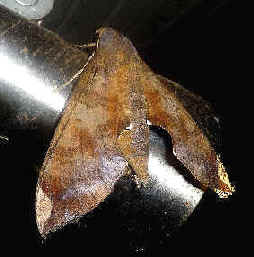
Fig Sphinx Moth
- Pachylia syces ______ BZ
HN
The nominate, Pachylia syces syces,
occurs from Mexico to southern Brazil and Uruguay. It is replaced by P.
s. insularis in the Caribbean islands of the West Indies.
- Pachylioides resumens ______ H#7842
BZ
CR HN pb (BMCR:83) (in subfamily
Macroglossinae)
Pachylioides resumens
occurs throughout the Neotropics, including in Caribbean islands. Strays
have been reported in the US in Florida and Texas.
- Perigonia ilus ______ CR
(100C:19-c)
The caterpillars of Perigonia ilus
and Perigonia lusca (below)
can not be distinguished from each other, but in Costa Rica Perigonia
ilus occurs in dry forest.
- Perigonia jamaicensis ______ HN
- Perigonia lusca (ph) ______
M#7846 BZ
CR HN pb
(BMCR:83) (in subfamily Macroglossinae)
HALF-BLIND SPHINX MOTH
Perigonia lusca occurs from
Mexico to Brazil. In the US, it is locally common in parts of Florida.
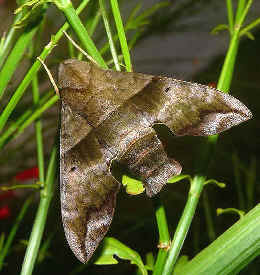
Half-blind Sphinx Moth
- Perigonia pallida ______ HN
pb
- Perigonia stulta ______ HN
Perigonia stulta is found across
the Neotropics as far north as Guatemala.
- Phryxus caicus ______ M#7840
BZ
CR HN (BMCR:83) (in subfamily
Macroglossinae)
CAICUS SPHINX MOTH
Phryxus caicus occurs in the
Neotropics from Mexico to South America. It also breeds in Florida in the
US, and strays north to South Carolina.
- Protambulyx eurycles ______ CR
(BMCR:78) (in subfamily Smerinthinae)
There have been a few specimens of Protambulyx eurycles in Costa Rica. It is
also found in South America from Colombia to southern
Brazil.
- Protambulyx goeldii ______ CR
(BMCR:78) (in subfamily Smerinthinae)
- Protambulyx strigilis ______ M#7818
BZ
CR HN pb (BMCR:78) (W:255) (100C:71-c) (in subfamily
Smerinthinae) (species described by
Linnaeus in 1771)
STREAKED SPHINX MOTH
Protambulyx strigilis occurs in Central America and south to northern
Argentina.
- Protambulyx xanthus ______ BZ
- Pseudosphinx tetrio (ph)
______ M#7830 BZ CR
HN (BMCR:83)
(in subfamily Macroglossinae) (species
described by Linnaeus in 1771)
TETRIO SPHINX MOTH
Pseudosphinx tetrio occurs widely from Mexico and the West Indies to
Central America and South America south to Brazil.
In the US, breeding populations occur in Florida, and occasionally in Texas.
Strays have wandered in the US as far north as New Jersey and Connecticut.
The caterpillar of Pseudosphinx tetrio is large, with a
distinctive yellow and black body and a red head. These caterpillars are
commonly seen feeding on Wild Jasmine Trees, Plumeria obtusa, and they
can strip the tree bare of leaves in just a matter of days. The caterpillar's
feeding does not cause any damage as the tree soon leafs out again.
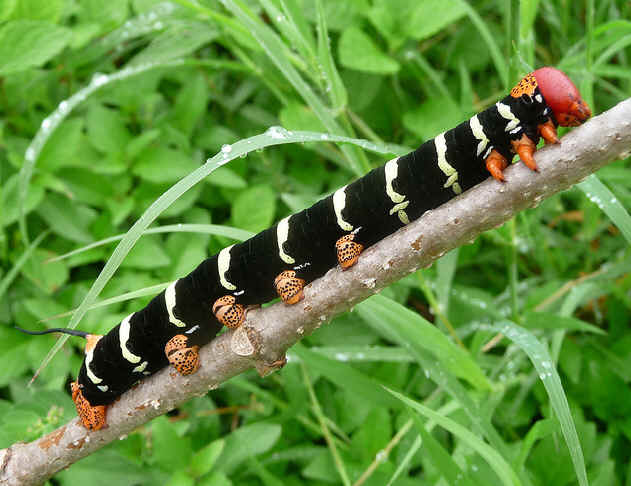
Above: The large, colorful caterpillar of the Tetrio
Sphinx Moth.
It has been seen during FONT tours in the Cayman Islands.
Below: the adult moth.
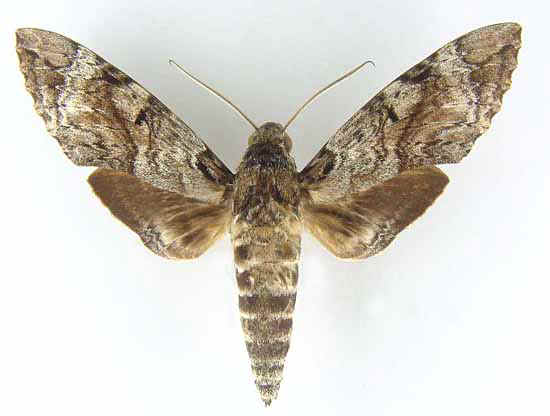
Moths in the New World that have been in the Sphinx
genus (below) are now in the genus
Lintneria.
The Sphinx genus continues in the
Old World.
- Sphinx leucophaeata (now
Lintneria leucophaeata) ______ HN
- Sphinx merops (now Lintneria
merops) (phTM) ______ BZ
CR HN (BMCR:79)
(in subfamily SPHINGINAE) (species described by Linnaeus in
1758)
- Sphinx praelongus (now
Lintneria praelongus) ______ HN
- Stolidoptera tachasara ______ CR
HN
(BMCR:83) (in subfamily Macroglossinae)
- Unzela japix ______ CR
HN
(100C:64-c)
The nominate, Unzela japix japix.
occurs from Mexico to Amazonia. It is replaced by U. j. discrepans in
southern Brazil.
- Xylophanes acrus (phTM)
_____ HN
- Xylophanes adalia ______ BZ
- Xylophanes amadis ______ BZ
HN pb
Xylophanes amadis cyrene ______ HN
pb
- Xylophanes anubus ______ BZ
HN
Xylophanes anubus occurs from
widely from Mexico to Argentina.
- Xylophanes belti ______ BZ
HN pb
- Xylophanes ceratomioides (phTM) ______
M#7891.1 BZ
HN pb
Xylophanes ceratomioides occurs
from central Mexico to northern Argentina.
- Xylophanes chiron (phHN) ______ BZ
CR HN pb
(BMCR:84,85co) (100C:51-c) (in subfamily
Macroglossinae)
Xylophanes chiron nechus is found across most of Central
America and South America.
Other subspecies are:
X. c. chiron in Jamaica,
X. c. cubanus in Cuba,
X. c. lucianus on Saint Lucia,
Martinique, and on nearby islands.
- Xylophanes crotonis ______ CR (100BM:30-c)
- Xylophanes damocrita ______ HN
- Xylophanes eumedon ______ HN
- Xylophanes falco ______ HN
- Xylophanes germen
______ CR HN (100C:52-c)
Xylophanes germen germen ______ HN
- Xylophanes guianensis
______ CR (100C:13-c)
- Xylophanes hannemanni ______ HN
- Xylophanes juanita ______ BZ
CR HN (100C:5-c)
- Xylophanes libya (phTM) ______
M#7891 BZ HN pb
- Xylophanes loelia ______ HN
Xylophanes loelia occurs from
Central America south to northern Argentina.
- Xylophanes maculator ______
BZ
- Xylophanes neoptolemus (phTM) ______ BZ
HN pb
- Xylophanes pistacina ______ HN
Xylophanes pistacina occurs from
Mexico to southern Brazil.
- Xylophanes pluto ______ M#7857
BZ
CR HN pb
(BMCR:83) (W:278) (in subfamily Macroglossinae)
PLUTO SPHINX MOTH
Xylophanes pluto has a wide range
from Mexico to northern Argentina, including also the West Indies and in the
US southern Texas and Florida.
- Xylophanes porcus (phTM) ______
M#7888 BZ CR HN pb
(100BM:29)
PORCUS SPHINX MOTH
Xylophanes porcus continentalis
is found across Central America and South America. It is replaced in Cuba by
the nominate X. p. porcus.
- Xylophanes pyrrhus ______ HN
pb
- Xylophanes rhodina ______
CR (BMCR:83) (in subfamily
Macroglossinae)
- Xylophanes tersa (ph) ______
M#7890 BZ
CR HN
(BMCR:84co) (PNE:269) (W:278) (in subfamily
MACROGLOSSINAE) (species described by Linnaeus in 1771)
TERSA SPHINX MOTH
Xylophanes tersa tersa occurs
widely from southern Canada to Argentina. The most northerly breeding record
is in New Jersey.
The nominate is replaced by the much darker newly-described subspecies X.
t. chaconi in Venezuela, described in 1996.
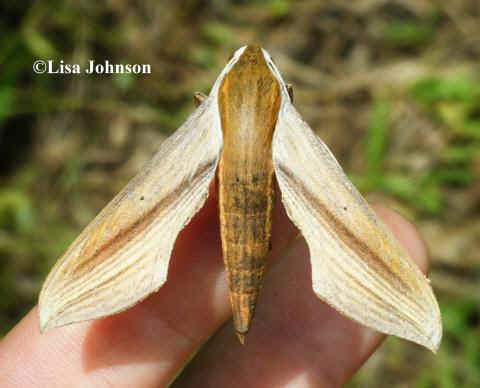
Tersa Sphinx Moth
(copyrighted photo by Lisa Johnson)
- Xylophanes thyelia (phTM) ______ BZ
HN pb (species described by Linnaeus in 1758)
Xylophanes thyelia thyelia
occurs across most of South America. It is replaced by X.
t. salvini in Central America.
- Xylophanes titana ______ BZ
CR HN (ICR:109)
Xylophanes titana occurs from
Mexico to Argentina.
- Xylophanes turbata ______ BZ
HN
- Xylophanes tyndarus ______
BZ CR HN pb (100BM:15-c)
Xylophanes tyndarus tyndarus ______ HN
pb
Xylophanes tyndarus occurs from
Mexico to Argentina.
- Xylophanes undata ______ BZ
HN pb
- Xylophanes zurcheri ______ BZ
HN pb
Family LYMANTRIIDAE: TUSSOCK MOTHS
Most of LYMANTRIIDAE are found in
the tropics of the Old World. There are about 2,000 species worldwide.
Adult moths in LYMANTRIIDAE do not feed.
- Caviria vinasia (phTM) ______ BZ
HN
SATIN MOTH
- Caviria sp. ______ HN pb
- Eloria subnuda ______ HN
- Orgyia sp. janzen01 ______ CR
A lymantriid of the dry forest of
Guanacaste (northwest Costa Rica), Orgyia sp,
janzen01 has a biology similar to that of Lymantria
dispar, the Gypsy Moth from Europe (also in
LYMANTRIIDAE).
- Sarsina purpurascens ______ CR
(100BM:63-c)
- Terphothrix tibialis
______ HN
Family SEMATURIDAE:
AMERICAN SWALLOWTAIL MOTHS
Large day-flying or night-flying moths,
usually tailed and similar to URANIIDAE (at the beginning of this
list).
The position of the family is not certain, but is usually considered related
to the superfamily GEOMETROIDEA (above, in this list, prior to the
Giant Silk Moths).
In the SEMATURIDAE, there are about 30 species in the Neotropics,
and a single species in South Africa.
- Coronidia canace ______ HN
- Coronidia egina ______ CR
(BMCR:186)
- Coronidia leachii ______ CR
(BMCR:186)
- Coronidia ribbei ______ CR
(BMCR:186)
- Coronidia subpicta ______ CR
(BMCR:186,187)
- Homidiana canace ______ CR
(BMCR:187)
- Homidiana hypasis ______ CR
(BMCR:188)
- Homidiana orithea ______ CR
(BMCR:187)
- Sematura lunus ______ CR
HN pb (BMCR:188)
(species described by Linnaeus in 1758)
Family
NOTODONTIDAE: PROMINENTS
Medium to large moths. A few of them small.
The family is nearly cosmopolitan, with more than 2,800 species having been
described. About 300 species have been found in Costa
Rica.
The distinctive subfamily DIOPTINAE follows this list of species
otherwise in NOTODONTIDAE. .
- Ankale maltha ______ BZ
- Antaea lichyi ______ CR
(BMCR:212co)
- Antaea omana ______ BZ
HN pb (in subfamily HETEROCAMPINAE)
- Anurocampa mingens ______ CR
(BMCR:213co) (100C:45-c)
- Apela dubiosa ______ BZ
- Apela neobule ______ BZ
HN pb (in subfamily HEMICERATINAE)
- Bardaxima lucilinea ______ BZ
CR (BMCR:208,212c)
- Bardaxima meyeri ______ HN pb
(in subfamily NYSTALEINAE)
- Bardaxima perses ______ CR (BMCR:211co)
(100BM:19-c)
- Calledema argenta ______
BZ HN pb (in subfamily NYSTALEINAE)
- Calledema contingata ______
CR (BMCR:208)
- Calledema jocasta ______
HN pb (in subfamily NYSTALEINAE)
- Calledema plusia
______ CR
(100BM:20-c)
- Canodia diffornis ______ BZ
- Cerura dandon ______ BZ CR
(BMCR:212co) (100BM:87-c)
- Cerura rarata ______ M#7944
BZ
CR HN pb (100BM:88-c)
(in subfamily NOTODONTINAE)
- Chliara cresus ______ BZ
HN pb (in subfamily HETEROCAMPINAE)
- Colox apulus ______ CR
(BMCR:211co) (100C:31-c)
- Colox phocus ______ BZ CR
HN pb (BMCR:208) (in
subfamily HETEROCAMPINAE)
- Colox sp. ______ HN pb
- Contrebia extrema ______ HN
(in subfamily HETEROCAMPINAE)
- Crinodes besckei (phTM)
______ CR HN pb
(100C:32-c) (in subfamily DUDUSINAE)
BRAZIL NUT PROMINENT
- Crinodes guatemalena ______
BZ HN pb (in subfamily DUDSINAE)
- Crinodes schausi ______ BZ
HN (in subfamily DUDUSINAE)
- Crinodes striolata ______ CR
HN pb
(BMCR:208,212c) (in subfamily DUDUSINAE)
- Dicentria rustica
______ CR (BMCR:211co)
- Dicentria violacens
______ CR (BMCR:210co)
- Didugua violascens ______ HN
(in subfamily NYSTALEINAE)
- Disphragis livida ______ BZ
HN pb (in subfamily HETEROCAMPINAE)
- Disphragis remuria ______ BZ
HN pb (in subfamily HETEROCAMPINAE)
- Disphragis tharis ______
HN pb (in subfamily HETEROCAMPINAE)
- Drastoma dardania
______ CR (BMCR:208)
- Drugera morana ______
BZ HN pb (in subfamily HETEROCAMPINAE)
- Elasmia astuta ______ BZ
HN pb (in subfamily NYSTALEINAE)
- Elasmia pronax ______ BZ
- Elymiotis alata ______ CR
(100C:99-c)
Elymiotis alata
is a rare inhabitant of rain forest.
- Elymiotis attenuata ______ CR
Elymiotis attenuata and the following 3 species are inhabitants of the dry
forest in northwest Costa Rica.
These 4 species are not easy to identify as they share many features, but
males and females of each are very different in appearance.
- Elymiotis janzen01 ______ CR
- Elymiotis janzen02 ______ CR
- Elymiotis janzen 03 ______ CR
- Elymiotis lignicolor ______ BZ
- Eragisa barnesi
______ CR (BMCR:208)
- Eragisa sabulosa ______ BZ
- Euhapigiodes hallwachsae
______ CR (100C:20-c)
- Eunystalea ebalea ______ BZ
- Eustema dara
______ CR (BMCR:208)
- Farigia magniplaga ______ HN pb
- Farigia sp. ______
HN pb
- Hapigia annulata ______
HN pb
- Hapigia dorema ______ BZ
- Hapigia jeturna ______
BZ
- Hapigia repandens ______ BZ
HN pb
- Hapigia simplex
______ BZ CR HN pb (BMCR:210co)
- Hapigia sp. ______ HN pb
- Hapigia sp. ______ HN pb
- Hapigiodes fredericka ______ BZ
- Hapigiodes xoloti ______ BZ
- Hemiceras alba ______ BZ
HN (in subfamily HEMICERATINAE)
- Hemicera bilinea ______ HN
(in subfamily HEMICERATINAE)
- Hemiceras conspirata
______ CR (BMCR:210co)
- Hemiceras micans ______ BZ
- Hemiceras muscosa ______ BZ
- Hemiceras punctata
______ CR (BMCR:208)
- Hemiceras sparsipennis ______ BZ
- Hemiceras vecina ______ BZ
- Hemicera sp. ______ HN pb
- Hemipecteros gestrive
______ CR (BMCR:209)
- Heterocampa remuria ______ CR
(BMCR:209)
- Lepasta bractea ______ BZ
HN pb (in subfamily NYSTALEINAE)
- Lepasta grammodes ______ BZ
HN pb (in subfamily NYSTALEINAE)
- Lirimiris gigantea ______
BZ CR (100C:97-c)
- Lirimiris guatemalensis ______ HN pb
- Lirimiris lignitecta ______ HN
pb
- Lirimiris meridionalis ______ BZ
HN pb
- Lirimiris mirabilis
______ CR (BMCR:209)
- Lirimiris postalbida
______ CR (BMCR:211co)
- Magava multilinea ______ HN pb
- Malocampa albolineata ______
BZ
- Malocampa danala
______ CR (BMCR:209)
- Malocampa puella ______ BZ
- Malocampa punctata ______
BZ
- Malocampa sida ______ BZ
- Malocampa sorax ______ BZ
- Marthula cynrica ______ BZ
HN (in subfamily NYSTALEINAE)
- Marthula rufescens ______ BZ
- Moresa valkeri
______ CR
(100BM:1-c)
in the subfamily PHALERINAE
- Naprepa houla
______ CR (BMCR:210co)
(100C:46-c)
- Naprepa sp. ______ HN pb
- Navarcostes limnatis
______ CR (BMCR:212co)
(100C:7-c)
- Notoplusia marchiana
______ CR (BMCR:209)
- Nystalea aequipars ______ CR
(100C:100-c) (in subfamily NYSTALEINAE)
Nystalea aequipars is
basically an inhabitant of rain forest. Its 5 or 6 food plants (of the
caterpillar) are species of Clusia, ground-rooted
epiphytes.
- Nystalea clotho ______ HN
(species described in 2002)
- Nystalea collaris
______ M#7946 BZ CR
(BMCR:213co) (100C:6-c)
- Nystalea ebalea ______ CR
- Nystalea lineiplena ______ BZ
- Nystalea malga ______ HN pb
- Nystalea nyseus ______ BZ
- Nystalea ocellata ______ BZ
- Nystalea postpuncta ______ BZ
- Nystalea superciliosa ______ BZ
HN pb
- Nystalea unguicularis ______ HN
(species described in 2002)
- Pentobesa lignicolor ______ HN
pb
- Pentobesa maya ______ HN
(species described in 2008)
- Pentobesa valta ______ BZ
- Pentobesa xylinoides ______ HN
pb
- Rhapigia accipiter
______ CR (BMCR:209)
- Rhuda difficilis
______ BZ CR HN pb (BMCR:209)
(100C:61-c)
- Rhuda tuisa ______ HN pb
- Rifargia astuta ______
BZ
- Rifargia causia
______ BZ CR
(BMCR:209)
- Rifargia demissa ______
BZ
- Rifargia dissepta
______ CR (BMCR:210co)
- Rifargia distinguenda ______ M#7966
BZ
- Rifargia felderi ______ BZ
- Rifargia gelduba ______
BZ HN pb
- Rifargia onerosa ______
BZ
- Rifargia sp. ______ HN pb
- Rifargia sp. ______ HN pb
- Rifargia sp. ______ HN pb
- Rosema attenuata
______ CR (BMCR:213co)
- Rosema apicalis ______ HN
- Rosema dentifera ______ BZ
- Rosema epigena ______ HN pb
- Rosema thestia ______ HN pb
- Sericochroa arecosa ______ BZ
HN pb
- Sericochroa luculenta ______ BZ
- Strophocerus albonotatus ______
BZ HN pb
- Strophocerus rectilinea ______
BZ
- Strophocerus thermesia ______ CR
(100BM:73-c)
- Symmerista meridionalis
______ HN (species described in 2007)
- Trichomaplata sp.
______ HN pb
In the family
NOTODONTIDAE
(above), the Subfamily DIOPTINAE
DIOPTINAE
are confined to the New World, particularly in the tropics. About 500
species have been described to date.
They are brightly colored, and could be confused with ARCTIIDS.
- Brachyglene crocearia ______
HN
- Dioptis butes ______ HN
- Dioptis eteocles ______
HN
- Ephialtias pseudena ______
HN
- Erbessa salvini ______ CR
(BMCR:215) (100BM:65-c)
- Getta turrenti ______ HN
(species described in 2009)
- Isostyla ithomeina ______ HN
- Josia enoides ______ HN
- Josia frigida ______ HN
- Josia fusigera ______ HN
- Josia gigantea ______
CR (BMCR:215)
- Josia hyperia ______ HN
- Josia integra ______
HN
- Josia megoera ______
HN
- Josia sp. ______ HN
- Lyces ariaca ______ HN
- Lyces tamara ______ HN
- Oricia homalochroa ______ CR
(BMCR:215)
- Oricia truncata ______ BZ
HN pb
- Phaeochlaena gyon ______ HN pb
- Phaeochlaena tendinosa ______
HN
- Phanoptis cyanomelas ______ CR
HN pb
(BMCR:215)
- Scotura annulata ______ HN
- Tithraustes albinigra ______
CR (BMCR:215)
- Tithraustes butes ______ BZ
- Tithraustes erymas ______ CR
- Tithraustes maximus ______
CR (BMCR:215)
- Tithraustes mirna ______ CR
(BMCR:215)
- Xenosoma cytheris ______ CR
(BMCR:215)
- Zunacetha annulata ______
M#8032 CR
(100BM:66-c)
Family DOIDAE
Sometimes
considered a subfamily of NOTODONTIDAE (above).
Some moths in DOIDAE have been placed in ARCTIIDAE
(later in this list, now, as ARCTIINAE)
A Neotropical family
from western North America to northern South America.
Between 7 and 9 species have been described in 2 or 3 genera.
- Doa raspa ______ BZ
NOCTUID MOTHS, in the
families EREBIDAE, NOLIDAE, NOCTUIDAE
Some now in
EREBIDAE were in NOCTUIDAE.
NOCTUID MOTHS can be
small, or large. Most have gray or opaque colors, although some can be
striking..
Generally that have a stout body.
They are broadly distributed throughout the world and very diverse in
tropical regions.
Family
EREBIDAE,
Subfamily HERMINIINAE
- Bleptina hydrillalis ______ M#8375
HN
- Dogninades jactatalis ______ CR (BMCR:226)
- Lascoria leucorabdota ______ CR (BMCR:226)
- Lascoria sp. ______ HN pb
- Macrochilo andaca ______ CR
HN pb (BMCR:226)
- Macrochilo sp. ______ HN pb
- Mamerthes terminalis ______ CR
(BMCR:226)
- Nicetas panamensis ______ CR
(BMCR:226)
- Palthis bizialis ______ HN pb
- Palthis orasiusalis ______ HN
pb
- Palthis submarginata ______
CR (BMCR:226)
- Pyrgion repanda ______ CR
(BMCR:226)
- Rejectaria atrax ______ CR
(BMCR:227) (100BM:64)
- Rejectaria niciasalis ______ CR (BMCR:227)
- Rejectaria vinasalis ______ CR (BMCR:227)
- Scopifera antelia ______ CR
(BMCR:227)
- Scopifera lycagusalis ______ CR
(BMCR:227)
- Scopifera menippusalis ______ CR (BMCR:227)
- Strathocles pulla ______ CR (BMCR:227)
Family EREBIDAE, Subfamily
EREBINAE
(formerly CATOCALINAE)
Here, with EREBINAE
are tribes: CATOCALINI, EUCLIDIINI, METIPOTINI, OPHIUSINI, POAPHILINI,
THERMESIINI, and the subfamilies: OPHIDERINAE, SCOLIOPTERYGINAE
Moths in the subfamilies HYPENINAE,
CALPINAE, and EULEPIDOTINAE are in lists that follow those in EREBINAE.
- Acanthodica fosteri ______ CR
(BMCR:228)
- Achaea ablunaris ______ BZ
- Achaea lienardi ______
HN pb (in tribe OPHIUSINI)
- Alabama argillacea ______ M#8554
HN (in subfamily SCOLIOPTERYGINAE)
COTTON LEAFWORM MOTH
- Amolita sp. ______ HN pb
(in tribe OPHIUSINI)
- Amolita sp. ______ HN pb
(in tribe OPHIUSINI)
- Anomis editrix ______
M#8553 BZ
HN pb
(in subfamily SCOLIOPTERYGINAE)
- Anomis erosa ______ M#8545
BZ (PNE:329) (in subfamily SCOLIOPTERYGINAE)
YELLOW SCALLOP MOTH
- Anomis hemiscopsis ______ HN pb
(in subfamily SCOLIOPTERYGINAE)
- Anomis illita ______
BZ
HN
(in subfamily SCOLIOPTERYGINAE)
- Anomis rubida
______ CR (BMCR:228)
(in subfamily SCOLIOPTERYGINAE)
- Anomis sublineata ______ HN
(in subfamily SCOLIOPTERYGINAE)
- Argidia hypoxantha ______ HN pb
(in tribe CATOCALINI)
- Argidia palmipes
______ CR (BMCR:228)
(in tribe CATOCALINI)
- Ascalapha odorata (ph)
______ M#8649
BZ CR HN pb (BMCR:228) (ICR:114)
(PNE:337) (in tribe
THERMESIINI) (described by Linnaeus in 1758)
the BLACK WITCH
Ascalapha odorata is a huge moth, with a wing span of about 150mm. It is not
brightly patterned, being mostly various shades of brown with dark bands and
lines. It sometimes flies in the day, but mostly at night. At a distance, a
day-flying Black Witch could be mistaken for a butterfly, the Gold Rim
Swallowtail.
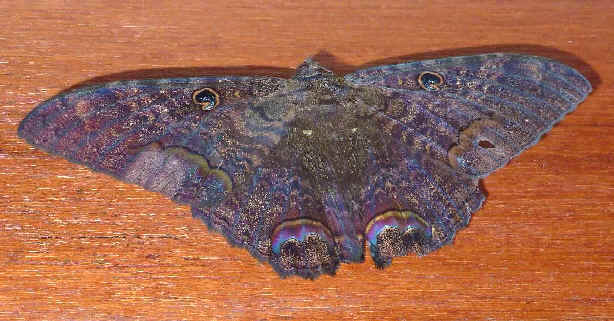
Above: a male Black Witch; below a female.
(upper photo courtesy of David MacDonald; lower photo by Sherry Nelson)
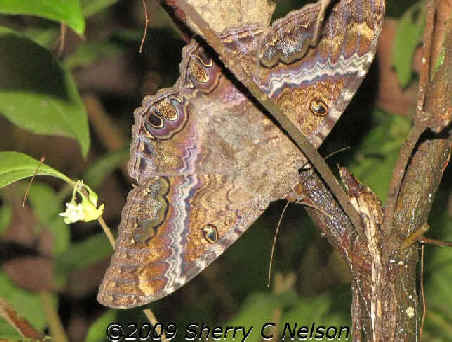
- Boryzops purissima
______ CR (BMCR:229)
- Calyptis iter
______ CR (BMCR:229)
- Calyptis semicuprea ______ HN
pb
- Catephiodes trinidadensis
______ HN pb
- Celiptera sp. ______ HN pb
(in tribe EUCLIDIINI)
- Ceroctena amynia
______ CR (BMCR:229)
- Coenipeta bibitrix ______ HN pb
(in tribe OPHIUSINI)
- Coenipeta damonia
______ CR HN pb (BMCR:229)
(in tribe OPHIUSINI)
- Coenipeta hemiplagia ______ HN
(in tribe OPHIUSINI)
- Coenipeta medalba ______
HN pb (in tribe OPHIUSINI)
- Coenipeta phasis ______ HN pb
(in tribe OPHIUSINI)
- Coenipeta tanais ______
HN pb (in tribe OPHIUSINI)
- Coenobela paucula ______ BZ
HN
- Cryptochrostis crocea ______ CR
(BMCR:230)
- Cymatophoropsis heurippa ______
CR (BMCR:230)
- Dyomyx psectrocera ______ CR
(BMCR:230)
- Dyops chromatophila ______ BZ
CR
(BMCR:230,238c)
- Dysgonia expediens ______ CR
HN pb (BMCR:230) (in tribe
POAPHILINI)
- Dysgonia purpurata ______ HN pb
(in tribe POAPHILINI)
- Epidromia pannosa ______ HN
(in tribe OPHIUSINI)
- Epidromia tinctifera ______ HN
(in tribe OPHIUSINI)
- Euclystis guerini ______
M#8664 CR
(BMCR:230)
- Euclystis insana ______ M#8664.1
BZ HN pb (in tribe OPHIUSINI)
- Euclystis plusiodes ______ HN
pb (in tribe OPHIUSINI)
- Eulepidotis alabastraria ______
BZ
- Eulepidotis guttata
______ CR (BMCR:231)
- Eulepidotis metalligera
______ BZ
- Eulepidotis stigmastica
______ CR (BMCR:231)
- Eulepidotis testaceiceps
______ CR (BMCR:231)
- Glenopteris occlifera
______ CR (BMCR:231)
- Glenopteris ornata
______ CR (BMCR:231)
- Goniapteryx servia
______ M#8544 BZ CR (BMCR:231)
- Graphigona regina ______ CR
(BMCR:232)
- Helia argentipes ______ HN
(in tribe OPHIUSINI)
- Helia celita ______ HN pb
(in tribe OPHIUSINI)
- Hemeroblemma acron
______ CR HN pb (BMCR:232)
(in tribe THERMESIINI)
- Hemeroblemma dolosa ______ HN
pb (in tribe THERMESIINI)
- Hemeroblemma mexicana
(ph) ______ M#8645.1 BZ
HN (in tribe THERMESIINI)
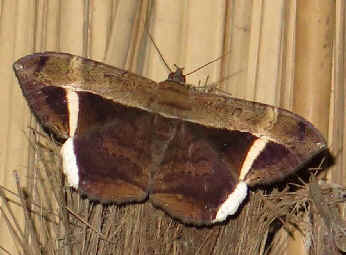
Hemeroblemma mexicana,
photographed in Belize in March 2015
(photo by Sean Werle)
- Hemeroblemma leontia (phTM) ______
HN
- Hemeroblemma opigena
______ M#8645 BZ HN pb
(in tribe THERMESIINI)
- Hemeroblemma schausiana
______ CR (BMCR:232)
- Hemeroblemma sp. ______ HN pb
(in tribe THERMESIINI)
- Hemicephalis agenaria ______ HN
pb (in tribe CATOCALINI)
- Hemicephalis alesa
______ CR
(BMCR:232,240c)
- Herminodes atrosignata ______ BZ
- Homoptera brevipennis ______ HN
(in tribe OPHIUSINI)
- Hypocala andremona
______ BZ CR (BMCR:233)
- Hypogrammodes balma ______ HN
pb (in tribe CATOCALINI)
- Itomia lignaris ______ HN
(in tribe OPHIUSINI)
- Itomia multilinea ______ HN
(in tribe OPHIUSINI)
- Itomia opistographa ______
HN
pb (in tribe OPHIUSINI)
- Kakopoda progenies ______
M#8669 HN (in tribe
OPHIUSINI)
- Lesmone formularis
______ M#8655 BZ
HN pb
CR (BMCR:233) (in tribe
OPHIUSINI)
Moths in the following genus, LETIS, have been said to be in the
subfamily OPHIDERINAE.
- Letis buteo ______ HN pb
(in tribe THERMESIINI)
- Letis herilia ______ HN pb
(in tribe THERMESIINI)
- Letis iphianasse (phTM)
______ HN (in tribe
THERMESIINI)
- Letis mycerina ______ BZ
CR HN (100BM:52-c)
(in tribe THERMESIINI)
- Letis orcynia ______ HN
(in tribe THERMESIINI) occurs in Central America and south to
Bolivia
MARBLED WITCH
The Marbled Witch is found in forest habitats from sea level to 5,400 feet.
It is commonly attracted to lights.
- Letis tuisana ______
CR (BMCR:233) (in tribe
THERMESIINI)
- Macrodes columbalis
______ CR (BMCR:233)
- Melipotis descreta ______ HN
(in tribe METIPOTINI)
- Melipotis famelica ______ M#8604
HN pb (in tribe METIPOTINI)
- Melipotis fasciolaris (phTM)
______ M#8599 CR HN pb
(BMCR:233) (in tribe METIPOTINI)
FASCIOLATED MELIPOTIS MOTH
- Melipotis nigrobasis ______ M#8602
HN
pb (in tribe METIPOTINI)
- Melipotis perpendicularis
______ M#8598 BZ HN
(in tribe METIPOTINI)
- Melipotis sp. ______ HN pb
(in tribe METIPOTINI)
- Metria angulata ______ BZ
- Metria aperta ______
HN pb (in tribe OPHIUSINI)
- Metria binea
______ CR (BMCR:233)
- Metria endopolia ______ HN pb
(in tribe OPHIUSINI)
- Metria simplicior ______
HN (in tribe OPHIUSINI)
- Mocis diffluens
______ BZ HN (in tribe
EUCLIDIINI)
- Mocis disseverans ______
HN (in tribe EUCLIDIINI)
- Mocis dyndima
______ BZ HN pb (in tribe
EUCLIDIINI)
- Mocis latipes
______ BZ HN pb (in tribe
EUCLIDIINI)
- Mocis marcida ______ HN
(in tribe EUCLIDIINI)
- Mocis texana ______ HN
(in tribe EUCLIDIINI)
- Nymbis iniqua ______ HN
- Ophisma minna ______ HN pb
(in tribe OPHIUSINI)
- Ophisma pyrosticha
______ CR (BMCR:233)
- Ophisma tropicalis
______ BZ HN pb (in tribe
OPHIUSINI)
- Orodesma apicina
______ CR (BMCR:234)
- Orodesma schausi ______ HN pb
(in tribe METIPOTINI)
- Oxidercia toxea
______ BZ CR (BMCR:234)
- Paracte schneideriana ______ BZ
CR (BMCR:234)
- Perasia garnoti ______
BZ
- Perasia helvina ______ HN
- Perasia ora ______ BZ
- Psedogerespa usipetes
______ CR (BMCR:234)
- Pseudobarydia crespula
______ CR (BMCR:234)
- Ptichoides immunis
______ BZ
- Ptichodes basilans ______ HN
- Ptichodis bistrigata ______ HN
(in tribe EUCLIDIINI)
- Ramphia albizona
______ BZ HN pb (in tribe
CATOCALINI)
- Selenisa sueroides
______ M#8658 BZ
CR HN pb (BMCR:242co)
(100C:84-c) (in tribe OPHIUSINI)
PALE-EDGED SELENISA MOTH
In Costa Rica, Selenisa sueroides
is in both dry forest and rain forest, but in the dry forest it can be
exceedingly common.
Food plants for the caterpillars of Selenisa
sueroides are in FABACEAE,
the bean family.
- Taxonprucha diffundens ______ HN
(in tribe OPHIUSINI)
- Thermesia sobria ______ HN
(in tribe THERMESIINI)
- Thysania agrippina (ph)
______ CR HN pb PN (BMCR:234)
(in tribe THERMESIINI)
the WHITE WITCH (other names are: Birdwing Moth, Ghost Moth, Great Gray Witch, Great Owlet
Moth)
Thysania agrippina has a wingspan of up
to 12 inches.
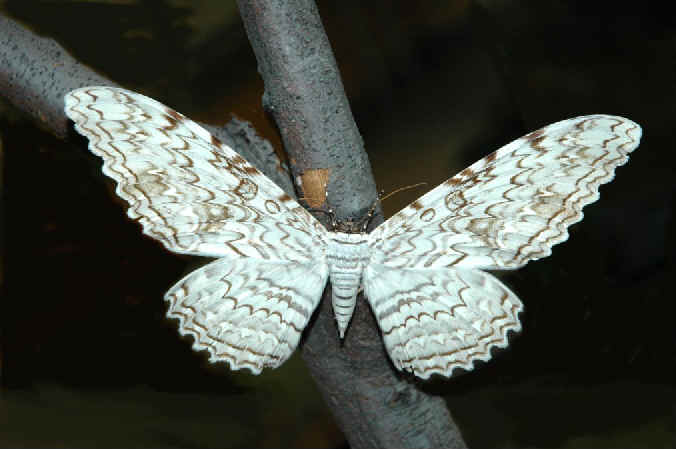
Above & below: the White Witch
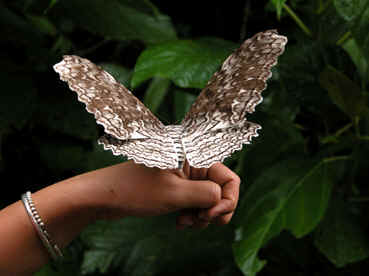
- Thysania zenobia (ph)
______ M#8647 BZ CR
THE OWL MOTH
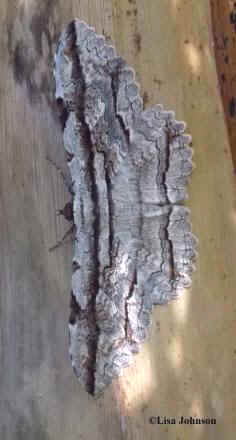
Blending in on the side of a tree,
an Owl Moth
(photo by Lisa Johnson)
- Zale fictilis ______
M#8687 BZ
- Zale galactea
______ CR (BMCR:234)
- Zale peruncta
______ M#8684.1 CR (100BM:51-c)
Family EREBIDAE,
Subfamily ANOBINAE
- Anoba pohli ______ HN pb
- Baniana ostia ______ BZ
HN pb
- Baniana suggesta ______ HN
- Baniana ypita ______ HN
Family EREBIDAE,
Subfamily EUBLEMMINAE
- Eublemma cinnamomea ______
M#9077 BZ HN
pb
Family EREBIDAE,
Subfamily PHYTOMETRINAE
- Cecharismena darconis ______ HN
pb
- Isogona natatrix ______
M#8492 HN
- Mursa phtisialis ______ M#8477.2
HN pb
- Phytometra flacillaalis ______ HN
- Radara aquilalis ______ HN pb
- Radara nealcesalis ______ BZ
HN pb
- Radara nezeila ______ HN pb
- Radara tauralis ______ BZ
- Radara zoum ______ HN pb
- Radara sp. ______ HN pb
Family EREBIDAE,
Subfamily HYPOCALINAE
- Hypocala andremona ______
M#8642 HN pb
HYPOCALA MOTH
- Goniapteryx servia ______ HN pb
Family EREBIDAE, Subfamily
HYPENINAE: SNOUTS
- Hemeroplanis scopulepes ______
M#8467 BZ
VARIABLE TROPIC MOTH
- Hypena andraca (phTM)
______ HN
- Hypena covitalis ______ CR
(BMCR:235)
- Hypena gaudialis ______ CR
(BMCR:235)
- Hypena glumalis ______ CR
(BMCR:235)
- Hypena levana ______ CR
(BMCR:235)
- Hypena livia ______ CR
(BMCR:235)
- Hypena perialis ______ HN pb
- Hypena porrectalis ______
HN
- Hypena subidalis ______ M#8448.1
HN
- Hypena variabilis ______ M#8454
CR
(BMCR:235)
- Hypena xenaresalis ______ CR
(BMCR:235)
- Hypena sp.
______ HN pb
- Trauaxa obliqualis
______ HN pb
Family EREBIDAE,
Subfamily CALPINAE
- Arabriga bimaculata ______ HN
- Azatha retardens ______
HN
- Baecula gallopavo (phTM) ______ CR
HN (100C:24-c)
GALLOPAVO
Baecula gallopavo
was previosuly Lepidodes gallopavo
or Lepidodes limbulata.
Its range is in Central America and northern South America.
- Briarda semiplaga ______
HN
- Canatha subangulalis ______ HN
- Ceroctena amynta ______ HN pb
- Dialithis gemmifera ______ BZ
- Dyops chromatophila ______ HN
pb
- Dyops dotata ______ HN
- Eudocima apta ______
M#8543 HN
- Eudocima colubra ______ CR
(BMCR:231,239c) (100C:17-c)
Eudocima colubra
is one of the tropical "underwings", with a color pattern
similar to that of the North American noctuids in the genus
Catocala.
Eudocima colubra feeds on rotting
or fermenting fruit and on yeast-filled fermenting wounds in tree
trunks.
- Eudocima materna ______ CR
(BMCR:231)
- Eudocima procus ______ HN
- Ferenta castula ______ CR
(100BM:45-c)
- Gonodonta biarmata ______
HN pb
- Gonodonta bidens ______
H#8542.1 CR HN pb
(BMCR:232)
- Gonodonta correcta
______ CR (BMCR:232)
- Gonodonta holosericea
______ CR (BMCR:232)
- Gonodonta immacula ______ HN
- Gonodonta incurva
______ BZ
- Gonodonta indentata ______ HN
pb
- Gonodonta lincus
______ CR (BMCR:232)
- Gonodonta nitidimacula
______ M#8542.3 BZ HN pb
- Gonodonta paraequalis
______ BZ
- Gonodonta parens ______ HN pb
- Gonodonta pyrgo
______ M#8539
BZ CR HN pb (100BM:74-c)
- Gonodonta sicheas (phTM)
______ M#8537 BZ HN occurs
from Mexico to Brazil, also in the Antilles and in the US in Florida and
Texas
- Gonodonta sinaldus (phTM)
______ M#8538 BZ HN
pb occurs
from Texas to Venezuela and Trinidad
MOONSEED FRUITPIERCER
- Gonodonta syrna
______ BZ HN pb
- Gonodonta uxor ______ HN pb
- Gonodonta sp. ______ HN pb
- Gorgone augusta ______ BZ
CR
- Gorgone fellearis ______ HN pb
- Graphigona regina ______ HN pb
- Herminodes atrosignata ______
HN pb
- Lephana tetraphorella ______ HN
pb
- Lephana sp. ______ HN pb
- Lepidodes gallopavo ______
HN
pb
- Leucotela nigripalpis ______ HN
- Mazacyla relata ______ HN pb
- Obroatis distincta ______ HN pb
- Oraesia nobilis ______ HN pb
- Oxidercia thaumantis ______ HN
pb
- Oxidercia toxea ______ HN pb
- Pararcte schneideriana ______ HN pb
- Peteroma discisigna ______ HN
- Plusiodonta clavifera ______ HN
pb
- Pseudbarydia severa ______ HN
pb
- Sosxetra grata (ph) (phTM)
______ BZ CR HN pb
(100C:47-c) occurs from Belize and Guatemala to Peru
WALKER'S MOTH
Sosxetra grata is found in cloud
forest from 1,200 to 5,400 feet above sea level.
The adult Sosxetra grata, or Walker's
Moth, is painted in cryptic colors that match bark, dead leaves, and
twigs, as are so many of the adult noctuid moths.
It does particularly well at looking like a rotten or fungus-ridden fragment
of a dead leaf, no matter where it is sits during the
day.

Walker's Moth, photographed during a FONT tour
(photo by Marie Gardner)
- Tautobriga glaucopis ______ HN
pb
- Tautobriga euspila ______ HN pb
Family EREBIDAE,
Subfamily EULEPIDOTINAE
- Antiblemma abstrusa ______
CR (BMCR:228)
- Antiblemma amarga ______
HN pb
- Antiblemma anguinea ______ CR
(BMCR:228)
- Antiblemma hamilcar ______ HN
pb
- Antiblemma harmodia ______ CR
(BMCR:228)
- Antiblemma imitans ______ HN
- Antiblemma incarnans ______ HN
pb
- Antiblemma memoranda ______
HN
pb
- Antiblemma neptis ______ HN
pb
- Antiblemma rufinans ______ M#8577
HN
- Antiblemma stelligera ______ CR
(BMCR:228)
- Antiblemma sterope ______ HN
- Antiblemma sufficiens ______
HN
- Antiblemma trogocycla (phTM)
______ HN
- Antiblemma sp. ______ HN pb
- Anticarsia anisospila ______ HN
(in tribe PANOPODINI)
- Anticarsia gemmatalis (ph)
______ H#8574
BZ HN pb (PNE:365) (in tribe PANOPODINI)
VELVET BEAN CATERPILLAR MOTH
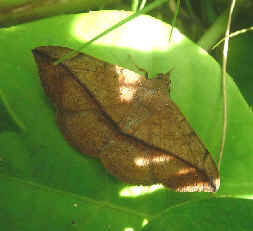
Velvet Bean Caterpillar Moth
- Athyrma adjutrix ______ HN pb
(in tribe PANOPODINI)
- Athyrma misera ______ BZ
- Azeta ceramina ______ HN
- Azeta quassa ______ CR
(BMCR:229)
- Azeta rhodogaster ______ CR
HN pb
(BMCR:229) (100BM:89-c) (in tribe PANOPODINI)
- Azeta signans ______ HN
- Epitausa atriplago ______ HN pb
- Epitausa coppryi ______
BZ
CR (BMCR:230)
- Eulepidotis addens ______ M#8569.1
HN pb (in tribe EULEPIDOTINI)
- Eulepidotis alabastraria ______
HN pb
- Eulepidotis carcistola ______ HN pb
- Eulepidotis electra ______ HN
pb
- Eulepidois hermura ______ HN pb
- Eulepidois inclyta ______ HN pb
- Eulepidois juncida ______ HN pb
- Eulepidois modestula ______ HN
pb
- Eulepidois perducens ______ HN
pb
- Eulepidois punctilinea ______ HN pb
- Eulepidois suppura ______ HN
- Eulepidois testaceiceps ______ HN pb
- Eulepidois sp. ______ HN pb
- Litoprosopus confligens ______ CR HN
(BMCR:233)
- Massala obvertens ______ M#8586
BZ
- Metallata absumens ______ M#8573
BZ
VARIABLE METALLATA MOTH
- Obrima pyraloides ______ HN
(in tribe EULEPIDOTINI)
- Syllectra congemmalis ______ BZ
Family EREBIDAE, Subfamily ARCTIINAE: TIGER MOTHS,
WASP MOTHS
The name ARCTIINAE is
from the Latin for "bear", Arctos, due to the furry larvae.
TIGER MOTHS (in the tribe ARCTIINI) are spectacular in a
number of ways. Not only are they numerous, and there are many species (as
many 11,000 species worldwide), they also often have brilliant coloration,
due to their toxicity (aposematism). Their attractive colors include
red, black, and yellow.
For their defense, they can detect sounds and ultrasounds (as against bats).
And they have other defense mechanisms, such as cataleptic states
(simulating death), and the ability to produce various repulsive substances.
ARCTID MOTHS (in ARCTIINI) are large and wide-winged.
They feed on a large variety of plants, especially herbs. Some species feed
on algae. They are often poliphagous.
Host plants that the caterpillars feed on include those in: Apocynaceae,
Asteraceae, Euphorbiaceae, Fabaceae, Myrtaceae, Rutaceae, and
Ulmaceae.
Some photos of ARCTIINAE caterpillars are in the book "Ecuador's
Butterfly Ecology" (EBE:215co).
WASP MOTHS (in the tribe CTENUCHINI) imitate wasps
almost perfectly (except for the wasp's abdominal constriction).
Caterpillars are mostly furry and brilliantly colored, to show their
toxicity. Some species can cause skin irritations in humans.
WASP MOTHS are diurnal, and abundant in the Neotropics. They have
narrow wings, often metallic.
Another tribe in ARCTIINAE is PERICOPINI. They are diurnal,
fragile and delicate. Some are large. The adults have attractive colors and
are sexually dimorphic. Some species are aposematic or mimetic of
other lepidoptera.
PERICOPINI are restricted to the New World, and occur especially in
the Neotropics.
- Aclytia albistriga ______ HN pb
(in tribe CTENUCHINI)
- Aclytia heber ______ HN pb
(in tribe CTENUCHINI)
- Aclytia punctata (phTM)
______ HN pb (in tribe CTENUCHINI)
- Aclytia reducta ______ HN pb
(in tribe CTENUCHINI)
- Aclytia sp. ______ HN pb
(in tribe CTENUCHINI)
- Agaraea longicornis ______ BZ
- Agaraea semivitrea ______ M#8256.2
BZ
- Agylia argentifera ______
BZ (in tribe LITHOSIINI, Lichen Moths)
- Agylia spp. (4) ______ HN pb
(in tribe LITHOSIINI)
- Agyrta dux ______ HN pb
(in tribe CTENUCHINI)
- Amastus aurantiacus
______ CR (BMCR:247)
- Amastus epicostosia
______ CR (BMCR:247)
- Amaxia apyga
______ BZ HN pb (in tribe
PHAEGOPTERINI)
- Amaxia beata
______ BZ HN pb (in tribe
PHAEGOPTERINI)
- Amaxia carinosa (phTM)
______ HN
- Amaxia chaon
______ CR (BMCR:247)
- Amaxia lepida
______ BZ
- Amaxia osmophora
______ BZ
- Amaxia pardalis ______ HN pb
(in tribe PHAEGOPTERINI)
- Amaxia sp. ______ HN
(in tribe PHAEGOPTERINI)
- Ammala helops
______ BZ
- Amphelarctia priscilla
______ BZ
- Anaxita drucei ______
HN (in tribe PHAEGOPTERINI)
- Anaxita decorata ______ HN
(in tribe PHAEGOPTERINI)
- Antichloris caca ______ HN
(in tribe CTENUCHINI)
- Antichloris viridis (phTM)
______ HN (in tribe CTENUCHINI)
occurs in Central America south to
Venezuela
SATIN STOWAWAY (or BANANA MOTH)
- Apistosia judas ______ HN
(in tribe LITHOSIINI)
- Arachnis aulaea ______ M#8155
HN
TIGER MOTH
- Arachnis dilecta ______
HN
- Ardonea morio ______ HN
(in tribe LITHOSIINI)
- Areva trigemmis ______ HN pb
(in tribe LITHOSIINI)
- Balbura dorsisigna ______ HN pb
(in tribe LITHOSIINI)
- Balbura fasciata
______ BZ HN pb (in
tribe LITHOSIINI)
- Balbura intervenata ______ HN
pb (in tribe LITHOSIINI)
- Baritius sannionis
______ BZ
- Belemnia inaurata
______ CR HN pb (BMCR:250)
(in tribe PHAEGOPTERINI)
- Belemnia trotschi
______ CR
(100BM:98-c)
- Bernathonomus piperita
______ CR (BMCR:247)
- Berthoidia albipuncta
______ BZ CR (BMCR:255co)
- Bertholdia fumida
______ CR (BMCR:247)
- Berthoidia specularis
______ BZ CR (BMCR:255co)
- Cacostatia sapphira
______ CR
(100BM:97-c)
- Calodesma maculifrons
______ BZ CR HN pb (BMCR:251)
(in tribe PERICOPINI)
- Carathis byblis
______ BZ
- Castrica phalaenoides (phTM)
______ BZ HN pb (in tribe
PHAEGOPTERINI)
- Chetone angulosa (ph) ______
BZ CR HN (BMCR:251)
(ICP:116) (in tribe PERICOPINI)
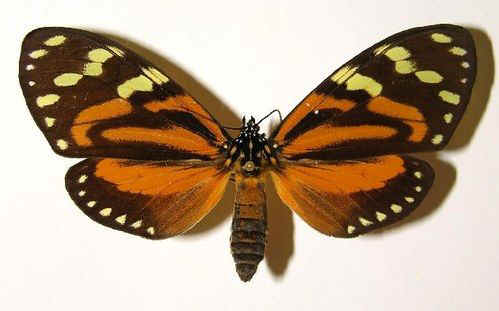
Chetone angulosa
- Chetone histria ______ HN
(in tribe PERICOPINI)
- Chetone ithomia
______ CR HN (BMCR:251)
(in tribe PERICOPINI)
- Chetone salvini
______ CR (BMCR:251)
- Chlorostola interrupta ______ HN pb (in tribe CTENUCHINI)
- Chrysocale principalis ______
HN (in tribe EUCHROMIINI)
- Chrysostola augusta ______ HN
pb (in tribe CTENUCHINI)
- Chrysostola moza ______
HN pb
(in tribe CTENUCHINI)
- Cissura plumbea (phTM)
______ BZ HN pb (in tribe
PHAEGOPTERINI)
- Cisthene polyzona ______ HN pb
(in tribe LITHOSIINI)
- Cisthene praxis
______ BZ (in LITHOSIINI)
- Composia fidelissima (ph)
______ M#8038 BZ
HN (in tribe PERICOPINI)
the FAITHFUL BEAUTY
Both the larva and the adult of Composia fidelissima are
highly conspicuous and diurnal.
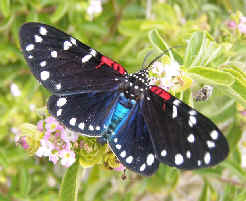
Faithful Beauty
- Correbidia costinotata ______ HN pb
(in tribe CTENUCHINI)
- Correbidia elegans ______
HN pb (in tribe CTENUCHINI)
- Correbidia germana ______ HN pb
(in tribe CTENUCHINI)
- Correbidia undulata ______ HN
pb (in tribe CTENUCHINI)
In the genus below, COSMOSOMA, there are
said to be about 185 known species, occurring in the Neotropics and in the
southern limits of the Nearctic, with the greatest diversity and abundance
in rainforests and cloud forests in South America, in Brazil, Ecuador, and
Peru.
- Cosmosoma achemon ______ HN pb
(in tribe EUCHROMIINI)
- Cosmosoma auge (phTM)
______ HN
- Cosmosoma braconoides ______
HN (in tribe EUCHROMIINI)
- Cosmosoma cingulatum ______ CR
HN pb
(100BM:23-c) (in tribe EUCHROMIINI)
- Cosmosoma demantria ______ (in
tribe CTENUCHINI) occurs from Mexico to Peru
BLUE-TAILED BEE-MIMIC
- Cosmosoma festiva ______ HN
(in tribe EUCHROMIINI)
- Cosmosoma hercyna ______ HN pb
(in tribe EUCHROMIINI)
- Cosmosoma intensa ______ HN
(in tribe EUCHROMIINI)
- Cosmosoma orathidia (phTM)
______ HN (in tribe EUCHROMIINI)
- Cosmosoma ruatana ______ HN
(in tribe EUCHROMIINI)
- Cosmosoma sectinota ______ HN
pb (in tribe EUCHROMIINI)
- Cosmosoma stibostictum (phTM)
______ HN pb (in tribe EUCHROMIINI)
- Cosmosoma teuthras (phTM)
______ M#8279 CR HN pb (100BM:24-c)
(in tribe EUCHROMIINI)
- Cratoplastis diluta (phTM) ______
BZ
HN pb (in tribe PHAEGOPTERINI)
- Ctenucha ruficeps ______ HN
(in tribe CTENUCHINI)
- Ctenucha venosa ______ M#8260
HN
(in tribe CTENUCHINI)
VEINED CTENUCHA MOTH
- Cyanarctica flavinigra
______ CR (BMCR:253)
(in tribe LITHOSIINI)
- Cyanopepla arrogans ______ HN
(in tribe CTENUCHINI)
- Cyanopepla scintillans
______ CR (BMCR:250)
- Delphyre hebes ______ HN
(in tribe CTENUCHINI)
- Delphyre testacea ______ HN pb
(in tribe CTENUCHINI)
- Diarhabdosia laudamia
______ BZ HN pb (in tribe
LITHOSIINI)
- Dinia aeagrus ______ BZ
HN pb (in tribe CTENUCHINI)
SCARLET-TIPPED WASP MIMIC-MOTH
- Diospage chrysobasis
______ CR (BMCR:250)
- Dycladia basimacula ______ HN
pb (in tribe EUCHROMIINI)
- Dycladia vitrina ______ HN pb
(in tribe EUCHROMIINI)
- Dysschema aorsa ______ HN
(in tribe PERICOPINI)
- Dysschema cerealis ______ HN
(in tribe PERICOPINI)
- Dysschema gaumeri
______ BZ
- Dysschema leucophaea
______ M#8037.1 BZ HN pb (in tribe
PERICOPINI)
- Dysschema lycaste ______ HN
(in tribe PERICOPINI)
- Dysschema magdala ______ BZ
HN pb (in tribe PERICOPINI)
- Dysschema marimne ______ HN
(in tribe PERICOPINI)
- Dysschema viuda
______ CR
(100BM:27-c)
- Dysschema sp. ______ HN pb
(in tribe PERICOPINI)
- Ecdemus obscurata ______ HN pb
(in tribe CTENUCHINI)
- Elysius conspersus
______ CR HN pb (BMCR:247)
(in tribe PHAEGOPTERINI)
- Elysius superba
______ BZ CR (BMCR:247)
- Epeiromulana roseata ______
HN
(described in 1952) (in tribe LITHOSIINI)
- Epimolis creon ______ BZ
- Episcepsis inornata ______ M#8275
HN
pb (in tribe CTENUCHINI)
- Episcepsis lenaeus ______ HN pb
(in tribe CTENUCHINI)
- Episcepsis thetis ______ HN pb
(in tribe CTENUCHINI) (described by Linnaeus in 1771)
- Episcepsis venata ______
HN pb
(in tribe CTENUCHINI)
- Eriphioides tractipennis ______
HN (in tribe CTENUCHINI)
- Estigmene acrea (ph) ______
M#8131 HN pb
(PNE:303)
SALT MARSH MOTH
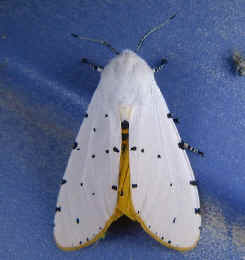
Salt Marsh Moth
(photo by Marcie O'Connor)
- Estigmene albida ______ M#8132
CR (BMCR:254co)
- Eucereon atriguttum ______ HN
(in tribe CTENUCHINI)
- Eucereon aroa ______
HN pb (in tribe CTENUCHINI)
- Eucereon aurantiaca ______ HN
pb (in tribe CTENUCHINI)
- Eucereon balium ______
HN pb (in tribe CTENUCHINI)
- Eucereon latifascia ______ HN
pb (in tribe CTENUCHINI)
- Eucereon maja ______ HN pb
(in tribe CTENUCHINI)
- Eucereon obscurum ______ HN pb
(in tribe CTENUCHINI)
- Eucereon pilatii ______ HN
(in tribe CTENUCHINI)
- Eucereon pseudarchias ______ HN
(in tribe CTENUCHINI)
- Eucereon rogersi ______ CR
PN occurs in
Central America, in Costa Rica and Panama, also on some Caribbean
islands
- Eucereon rosa ______ HN
(in tribe CTENUCHINI)
- Eucereon rosadora ______ HN pb
(in tribe CTENUCHINI)
- Eucereon varium ______ HN pb
(in tribe CTENUCHINI)
- Eucereon xanthura
______ CR (BMCR:255co)
- Euchaetes antica ______
M#8242 HN
(in tribe PHAEGOPTERINA)
- Eudesmia laetifera ______ HN
(in tribe LITHOSIINI)
- Eudesmia menea
______ M#8097 CR HN pb (BMCR:253) (in
tribe LITHOSIINI)
- Eunomia colombina ______ HN
(in tribe EUCHROMIINI)
- Eunomia latenigra ______ HN
(in tribe EUCHROMIINI)
- Eupseudosoma aberrans
______ BZ
- Eupseudosoma involuta
______ M#8257 in Central America, also parts of South America and
the Caribbean
SNOWY EUPSEUDOSOMA MOTH
Eupseudosoma involuta
has previously been Eupseudosoma nivea
and Eupseudosoma immaculata.
- Eurylomia cordula ______ HN
(in tribe LITHOSIINI)
- Euthyane grisescens ______ HN
pb (in tribe LITHOSIINI)
- Euthyane simplex ______ HN
(in tribe LITHOSIINI)
- Euthyane theodula ______ HN pb
(in tribe LITHOSIINI)
- Evius hippia
______ BZ HN pb (in tribe
PHAEGOPTERINI)
- Gardinia magnifica
______ CR (BMCR:253) (in
tribe LITHOSIINI)
- Glaucostola guttipalpis
______ BZ
- Glaucostola metaxantha (phTM)
______ BZ HN
- Gorgonidia buckleyi
______ CR HN pb (BMCR:248)
(in tribe PHAEGOPTERINI)
- Graphea marmorea
______ CR (BMCR:248)
- Gymnelia nobilis ______ HN pb
(in tribe EUCHROMIINI)
- Halysidota atra
______ BZ
- Halysidota excellens ______ HN
(in tribe PHAEGOPTERINI)
- Halysidota grandis ______ HN pb
(in tribe PHAEGOPTERINI)
- Halysidota interlineata
______ BZ (in tribe
PHAEGOPTERINI)
- Halysidota orientalis (ph)
______ BZ (in tribe
PHAEGOPTERINI)

Halysidota orientalis
- Halysidota pectenella ______ HN
pb (in tribe PHAEGOPTERINI) (species
described in 1980)
- Heliactinidia sitia ______ HN
(in tribe PERICOPINI)
- Heliura rhodophila ______ HN pb
(in tribe CTENUCHINI)
- Heliura tetragramma ______ HN
(in tribe CTENUCHINI)
- Homoeocera gigantea ______
HN (in tribe EUCHROMIINI)
- Horama oedippus
______ CR HN pb (BMCR:250)
(in tribe EUCHROMIINI)
- Horama panthalon ______ M#8287
GU HN PN (in tribe
EUCHROMIINI)
Horama panthalon texana ______ GU
subspecies in the US in Florida and from south Texas and the southwest
US, in AZ and NM, south to Guatemala
Horama panthalon panthalon ______ PN
subspecies in Panama, northern South America, and the Antilles
TEXAS WASP MOTH
- Horama plumipes (phTM)
______ M#8288 CR HN
pb (BMCR:250) (in tribe
EUCHROMIINI)
- Hyaleucerea gigantea
______ HN pb (in tribe CTENUCHINI)
- Hyaleucerea vulnerata ______ HN
pb (in tribe CTENUCHINI)
- Hyalurga sixola
______ BZ
- Hyalurga sora
______ BZ CR HN pb
(BMCR:251) (in tribe PERICOPINI)
- Hyalurga urioides
______ CR HN pb (BMCR:252)
(in tribe PERICOPINI)
- Hypercompe albescens
______ BZ
- Hypercompe caudata
______ M#8147 BZ HN
- Hypercompe icasia
______ CR
(100BM:53-c)
- Hypercompe leucartioides
______ BZ HN pb (species described
in 1967)
- Hypercompe perplexa
______ BZ HN pb
- Hyperthaema sororita
______ BZ
- Hypidalia sanguirena
______ CR (BMCR:248)
- Hypocrita albimacula (phTM)
______ HN pb
HYPOCRITA TIGER MOTH
- Hypocrita ambigua ______ HN
(in tribe PERICOPINI)
- Hypocrita aletta
______ CR (BMCR:252)
(ICR:118) (in tribe PERICOPINI)
Hypocrita aletta is a brightly
colored moth, with conspicuous, iridescent pale blue markings along the
margins of the wings. serving as a warning of its toxicity to birds.
- Hypocrita arcaei
______ BZ CR HN pb (BMCR:252)
(in tribe PERICOPINI)
- Hypocrita drucei
______ CR (BMCR:252)
(in tribe PERICOPINI)
- Hypocrita excellens ______ HN
(in tribe PERICOPINI)
- Hypocrita pylotis ______
HN
(in tribe PERICOPINI)
- Hypocrita reedia
______ CR (BMCR:252)
(in tribe PERICOPINI)
- Hyponerita tipolis
_____ BZ
- Idalus alteria ______ HN pb
(in tribe PHAEGOPTERINI)
- Idalus crinis
______ BZ HN pb (in tribe
PHAEGOPTERINI)
- Idalus dares (phTM)
______ BZ HN pb (in tribe
PHAEGOPTERINI)
- Idalus herois (phTM)
______ BZ HN pb (in tribe
PHAEGOPTERINI)
- Idalus intermedia
______ BZ
- Idalus lineosus
______ BZ
- Idalus tuisiana
______ CR (BMCR:248)
- Idalus vitrea
______ BZ CR HN pb (BMCR:248)
(in tribe PHAEGOPTERINI)
- Idalus vitreoides
______ BZ
- Illice citrina
______ CR (BMCR:253) (in
tribe LITHOSIINI)
- Illice opulentana
______ CR (BMCR:253)
(in tribe LITHOSIINI)
- Illice polyzona
______ BZ (in tribe LITHOSIINI)
- Isanthrene monticola
______ CR (BMCR:250)
- Lampruna rosea
______ BZ
- Lepidokirbyia vittipes
______ BZ
- Lophocampa alternata ______ HN
(in tribe PHAEGOPTERINI)
- Lophocampa annulata ______ HN
(in tribe PHAEGOPTERINI)
- Lophocampa catenulata ______ HN
pb (in tribe PHAEGOPTERINI)
- Lophocampa citrina ______ HN pb
(in tribe PHAEGOPTERINI)
- Lophocampa seruba ______ HN
(in tribe PHAEGOPTERINI)
- Lophocampa sobrina (phTM)
______ M#8210 HN
(in tribe PHAEGOPTERINI)
- Loxophlebia geminata ______
HN
pb (in tribe EUCHROMIINI)
- Loxophlebia masa ______ HN pb
(in tribe EUCHROMIINI)
- Lycomophodes correbiodes
______ CR (BMCR:253) (in
tribe LITHOSIINI)
- Lycomophodes reducta
______ CR (BMCR:253) (in
tribe LITHOSIINI)
- Lycomophodes sordida
______ M#8093.2 BZ HN pb (in tribe
LITHOSIINI)
- Lycomophodes strigosa
______ BZ (in tribe LITHOSIINI)
- Lycomophodes sp. ______ HN pb
(in tribe LITHOSIINI)
- Macrocneme adonis ______ HN
(in tribe EUCHROMIINI)
- Macrocneme auripes ______ HN
(in tribe EUCHROMIINI)
- Macrocneme cabimensis ______ HN
(in tribe EUCHROMIINI)
- Macrocneme chrysitis ______ M#8273
HN
(in tribe EUCHROMIINI)
SOUTHERN CYAN TIGER MOTH
- Macrocneme iole ______ HN pb
(in tribe EUCHROMIINI)
- Macrocneme lades ______ HN
(in tribe EUCHROMIINI)
- Macrocneme sp. ______ CR
(ICR:117) (in tribe EUCHROMIINI)
- Melese amastris ______ HN pb
(in tribe PHAEGOPTERINI)
- Melese asana
______ BZ HN pb (in tribe
PHAEGOPTERINI)
- Melese flavimaculata (phTM)
______ HN pb (in tribe PHAEGOPTERINI)
- Melese incertus
______ BZ
- Melese laodamia
______ BZ
- Melese punctata
______ BZ
- Melese sixola
______ CR (BMCR:248)
- Mesothen pyrrha ______ HN pb
(in tribe EUCHROMIINI)
- Mulona phelina ______ BZ
HN pb
(in tribe LITHOSIINI)
- Munona iridescens
______ CR HN pb (100C:91-c)
(in tribe PHAEGOPTERINI)
- Mydromera notochloris
______ CR HN (100BM:96-c)
(in tribe CTENUCHINI)
- Myrmecopsis ichneumonea
______ CR (BMCR:250)
- Myrmecopsis strigosa ______
M#8277 HN
(in tribe EUCHROMIINI)
- Napata leucotelus ______ HN pb
(in tribe CTENUCHINI)
- Napata walkeri ______ HN pb
(in tribe CTENUCHINI)
- Neacerea rufiventris ______ HN
pb (in tribe CTENUCHINI)
- Neonerita dorsipuncta
______ BZ CR
(100BM:54-c)
- Neritos atta
______ BZ
- Neritos cotes
______ BZ
- Neritos flavoroseus
______ BZ
- Neritos leucoplaga
______ BZ
- Neritos samos
______ BZ HN (in tribe
PHAEGOPTERINI)
- Nodozana hieroglyphica
______ CR (BMCR:253)
(in tribe LITHOSIINI)
- Nodozana picturata
______ CR (BMCR:253)
(in tribe LITHOSIINI)
- Notarctia proxima
______ BZ HN
- Nudar fractivittarum
______ BZ (in tribe LITHOSIINI)
- Opharus consimilis
______ BZ
- Opharus gemma
______ BZ
- Opharus quadrupunctata
______ BZ
- Ordishia godmani
______ BZ
- Ordishia rutilus
______ CR (BMCR:248)
- Ormetica abdalsan
______ BZ
- Ormetica ataenia
______ BZ HN pb (in tribe
PHAEGOPTERINI)
- Ormetica goloma ______ HN pb
(in tribe PHAEGOPTERINI)
- Ormetica guapisa ______ HN pb
(in tribe PHAEGOPTERINI)
- Ormetica nabdalsa
______ BZ
- Ormetica orbona ______ HN pb
(in tribe PHAEGOPTERINI)
- Ormetica pauperis
______ BZ
- Ormetica sicilia
______ BZ HN pb (in tribe
PHAEGOPTERINI)
- Ormetica taeniata
______ BZ HN (in tribe
PHAEGOPTERINI)
- Pachydota albiceps
______ BZ
- Parathyris cedonulli
______ BZ HN pb (in tribe
PHAEGOPTERINI)
- Pareuchaetes insulata
______ M#8227 BZ
HN pb (in tribe PHAEGOPTERINI)
YELLOW-WINGED PAREUCHAETES MOTH
- Parevia gurma ______ HN pb
(in tribe PHAEGOPTERINI)
- Parevia metachryseis
______ BZ
- Pelochyta arontes
______ BZ
- Pelochyta misera ______ HN pb
(in tribe PHAEGOPTERINI)
- Phaemolis lineatus (phTM)
______ BZ HN pb (in tribe
PHAEGOPTERINI)
- Phaloesia saucia
______ M#8039 CR (BMCR:252)
SAUCY BEAUTY MOTH
- Pheia albsigna ______
HN pb
(in tribe EUCHROMIINI)
- Phoenicoprocta sanguinea _____ HN pb (in tribe EUCHROMIINI)
- Poliopastea sp. ______ HN pb
(in tribe EUCHROMIINI)
- Pryteria costata
______ BZ
- Pryteria unifascia
______ BZ
- Pseudohemihyalea fallaciosa
______ HN (in
tribe PHAEGOPTERINI) (species described in 1997)
- Pseudohemihyalea labeculoides
______ HN (in
tribe PHAEGOPTERINI) (species described in 1995)
- Pseudohemihyalea porioni ______
HN (in tribe
PHAEGOPTERINI) (species described in 1995)
- Pseudomya melanthoides ______ HN pb (in tribe EUCHROMIINI)
- Pseudophaloe cerealia
______ CR (BMCR:252)
- Pseudophaloe troetschi
______ CR (BMCR:255co)
- Psoloptera basifulva (phTM)
______ HN pb (in tribe EUCHROMIINI) occurs in
Central America south to Peru
- Ptychotrichos episcepsidis
______ HN pb (in tribe CTENUCHINI)
- Pygarctia roseicapitis ______
M#8253 BZ
- Rhipha chionoplaga
______ BZ HN pb (in tribe
PHAEGOPTERINI)
- Rhipha flammans
______ CR (BMCR:249)
- Rhipha persimilis ______ HN
(in tribe PHAEGOPTERINI)
- Robinsonia deiopeia
______ BZ HN pb (in tribe
PHAEGOPTERINI)
- Robinsonia dewitzi
______ BZ
- Robinsonia sabata
______ BZ Hn pb (in tribe
PHAEGOPTERINI)
- Saurita fumosa ______
HN pb
(in tribe EUCHROMIINI)
- Saurita myrrha ______ HN pb
(in tribe EUCHROMIINI)
- Saurita temenus ______ HN pb
(in tribe EUCHROMIINI)
- Saurita tipulina ______ HN pb
(in tribe EUCHROMIINI)
- Scaptius submarginallis
______ BZ
- Scena potentia (phTM)
______ HN
- Selenarctica elissa ______
HN
pb (in tribe PHAEGOPTERINI)
- Selenarctia elissoides
______ BZ
- Sphaeromachia cubana
______ BZ
- Sphecosoma felderi ______
HN
(in tribe EUCHROMIINI)
- Sychesia dryas
______ BZ
- Symphlebia aryllis
______ CR (BMCR:249)
- Symphlebia herbosa
______ CR (BMCR:249)
- Symphlebia ipsea
______ CR (BMCR:249)
- Symphlebia lophocampoides
______ HN (in tribe PHAEGOPTERINI)
- Symphlebia tessellata
______ CR (BMCR:257co)
- Symphlebia underwoodi ______
HN
(in tribe PHAEGOPTERINI)
- Syntomeida melanthus
______ M#8283 CR HN (BMCR:254co)
(in tribe EUCHROMIINI)
BLACK-BANDED WASP MOTH
- Talara rubida ______ BZ
(in tribe LITHOSIINI)
- Talara synnephela ______ BZ
HN pb
(in tribe LITHOSIINI)
- Thysanoprymna superba ______ BZ
CR (BMCR:249)
- Trichromia alba ______ HN pb
(in tribe PHAEGOPTERINI)
- Trichromia cotes ______ HN pb
(in tribe PHAEGOPTERINI)
- Trichromia flavoroseus ______ HN (in tribe PHAEGOPTERINI)
- Trichromia sp. ______ HN pb
(in tribe PHAEGOPTERINI)
- Trichura cerberus (phTM) ______ CR
HN
(BMCR:250) occurs in Central America, Trinidad, Brazil
- Trichura coarctata ______ HN
(in tribe CTENUCHINI)
- Trichura druryi ______ HN
(in tribe CTENUCHINI)
- Trichura esmeralda ______ HN
(in tribe CTENUCHINI)
- Tricypha imperialis ______ BZ
- Tuina cingulata ______
BZ HN (in tribe LITHOSIINI)
- Utetheisa ornatrix (ph) ______
M#8105 BZ CR
HN pb
(PNE:307) (W:478) (in CALLIMORPHINI)
(described by Linnaeus in 1758)
ORNATE MOTH (or ORNAMENTED
UTETHEISA)
Utetheisa ornatrix is the New World counterpart of Utetheisa
pulchella, the Crimson Speckled Footman.
The forewing of Utetheisa ornatrix is yellowish white with
irregular, transverse white bands, each enclosing a line of small black spots,
and the hindwing is pink with marginal black marks.
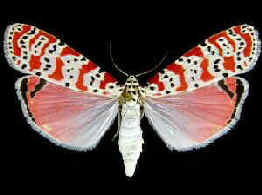
Above & below: the Ornate Moth
(lower copyrighted photo by Lisa Johnson)
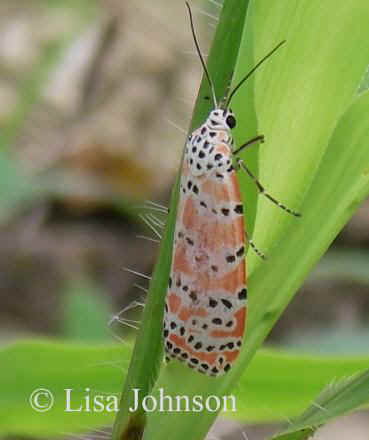
- Virbia birchi ______ BZ
HN pb
- Virbia rosenbergi ______ BZ
- Virbia sp. (phTM) ______
HN pb
- Viviennea ardesiaca ______ BZ
- Viviennea salma ______ BZ
- Viviennea tegyra ______ CR
HN pb
(BMCR:249) (in tribe PHAEGOPTERINI)
- Xanthyda xanthosticta ______ HN
pb (in tribe EUCHROMIINI)
- Xenosoma flaviceps ______ HN
(in tribe PERICOPINI)
- Xenosoma nigromarginatum ______
CR (BMCR:252)
- Zatrephes rosacea ______
BZ
Family EUTELIIDAE (has
been
NOCTUIDAE)
Also in this group: subfamily STICTOPTERINAE
Moths in EUTELIIDAE are small to medium-sized moths, many of
which have spectacular acrobatic resting positions.
They occur in a variety of habitats, and even in urban areas. They are
nocturnal, coming to lights in low numbers.
- Eutelia ablatrix ______ CR
(BMCR:236)
- Eutelia abscondens ______ CR
(BMCR:236)
- Eutelia auratrix ______ CR
HN pb (BMCR:236)
- Eutelia furcata ______ M#8968.2
CR
(BMCR:238co)
FLORIDA EUTELIA MOTH
- Eutelia sp. ______ HN pb
- Nagara clara ______ CR
(BMCR:237) (in subfamily
Stictopterinae)
- Nagara fenestra ______ CR
(BMCR:237) (in subfamily
Stictopterinae)
- Nagara heterogramma ______ CR
(BMCR:237) (in subfamily
Stictopterinae)
- Nagara vitrea ______ HN pb
- Paectes abrostoloides ______
M#8962 HN
(PNE:367) (W:376)
LARGE PAECTES MOTH
- Paectes albescens ______ HN
- Paectes devincta ______ CR
(BMCR:236)
- Paectes fovifera ______ HN pb
- Paectes fuscescens ______ HN
- Paectes glauca ______ HN pb
- Paectes lunodes ______ M#8963.1
CR
HN
(BMCR:236)
- Thyriodes terrabensis ______ CR
(BMCR:236)
Family NOLIDAE
Those in NOLIDAE are
small deltoid noctuid moths that rest with their rounded wings in a flat
position.
They are predominantly gray or white with patterns of dotted or broken
lines.
Many species have raised tufts of hair-like scales on the forewing.
NOLIDAE are most found in forests and fields. They are nocturnal,
attracted to lights in small numbers.
- Collomena olivaris ______ CR
(BMCR:246)
- Diplolopha cycloptera ______ CR
(BMCR:246)
- Elaeognatha argentea ______ CR
(BMCR:246)
- Elaeognatha argyritis ______ CR
(BMCR:246)
- Iscadia argentea ______ HN
- Iscadia furcifera ______ HN
- Iscadia mariva ______ CR
(BMCR:246)
- Iscadia producta ______ CR
(BMCR:246)
- Meganola leucostola ______ HN
pb
- Meganola placens ______ CR
(BMCR:246)
- Neostictoptera chlorotica
______ CR (BMCR:246)
- Neostictoptera nigripuncta
______ CR HN pb (BMCR:246)
- Nola caelata ______ CR
(BMCR:246)
- Nola turbana
______ HN pb
Family
NOCTUIDAE, Subfamily PLUSIINAE:
MILLER
MOTHS
- Agrapha ahenea ______ CR
(BMCR:218)
- Agrapha oxygramma ______ BZ
- Argyrogramma verruca ______ H#8885
BZ CR HN pb (BMCR:218)
(PNE:375)
GOLDEN LOOPER MOTH
- Autographa biloba ______ CR
(BMCR:218)
- Autoplusia egena ______ M#8891
HN
BEAN-LEAD SKELETONIZER MOTH
- Autoplusia egenoides ______ M#8893
CR
(BMCR:218)
- Chrysodeixis includens ______ M#8890
HN (PNE:377)
SOYBEAN LOOPER MOTH
- Mouralia tinctoides ______ CR
(BMCR:218)
- Plusia caudata ______
CR (BMCR:218)
- Plusia masoni ______ CR
(BMCR:218)
- Pseudoplusia includens ______ BZ
CR (BMCR:218)
- Rachiplusia ou ______ M#8895
BZ (PNE:377)
GRAY LOOPER MOTH
- Trichoplusia ni
______ M#8887 HN
(PNE:377)
NI MOTH
Family NOCTUIDAE, Subfamily BAGISARINAE
Moths in BAGISARINAE are
small to medium-sized noctuids, many with cryptic lichen-like markings.
They are nocturnal and will come to lights.
- Amyna octo ______ HN
- Bagisara albicosta ______ M#9174
CR
(BMCR:217)
- Bagisara avangareza ______ CR
(BMCR:21`7)
- Bagisara laverna ______ M#9175.2
CR
(BMCR:217)
- Bagisara patula ______ CR
HN pb
(BMCR:217)
- Bagisara rectifascia ______ M#9169
CR
(BMCR:217)
STRAIGHT-LINED MALLOW MOTH
- Bagisara repanda ______
M#9168 BZ
CR HN pb (BMCR:217)
WAVY-LINED MALLOW MOTH
- Bagisara tristicta ______ M#9176
CR
(BMCR:217)
Family NOCTUIDAE, Subfamily ACONTIINAE:
BIRD-DROPPING MOTHS
Those in ACONTIINAE are
small moths, most of which are excellent bird-dropping mimics. They occur at
forest edges and in fields, sometimes during the day. Most are nocturnal and
will come to lights.
- Acidaliodes celenna ______ HN
pb
- Acontia tetragona ______ CR
HN (BMCR:220)
- Eusceptis splendens ______ CR
(BMCR:220)
- Hoplotarache viridifera ______ CR
(BMCR:220)
- Ommatochila mundula ______ BZ
- Thioptera intensifica ______
CR (BMCR:220)
Family NOCTUIDAE, Subfamily ACRONICTINAE:
DAGGERS
Those in ACRONICTINAE, the DAGGERS, are
predominantly gray noctuid moths that often have black dagger-like dashes on the
forewing. Some can be difficult to identify.
They occur in forests and gardens. They are nocturnal and visit lights and sugar
bait in small numbers.
- Acronicta beameri ______ M#9234
CR
(BMCR:216)
- Acronicta velia ______ CR
(BMCR:216)
- Antachara rotundata
______ HN pb
- Argyrosticta ditissima
______ HN pb
- Argyrosticta vauaurea
______ HN pb
Family NOCTUIDAE, Subfamily CUCULLIINAE:
HOODED OWLETS
The CUCULLIINAE is a
distinctive group of moths that rest with their wings folded and their
forelegs outstretched.
A thick thoratic crest typically curls forward over the head to create a
"hooded" appearance, hence the name HOODED OWLETS.
They occur in forest and gardens. They are nocturnal and visit lights in
small numbers.
- Cucullia costaricensis
______ CR (BMCR:221)
- Cucullia lilacina
______ CR (BMCR:221)
- Dolocucullia buddhae
______ CR (BMCR:221)
The following genus, NEOGALEA, is now said to be in the subfamily
ONCOCNEMIDINAE.
In ONCOCNEMIDINAE, the
ONCOCNEMIDINE SALLOWS are mostly medium-sized, predominantly gray moths
that often sit with their wings slightly folded. Sometimes, however, the
wings are held flat.
They are nocturnal and visit lights in small numbers.
- Neogalea sunia ______ CR
HN (BMCR:221)
Family NOCTUIDAE, Subfamily
XYLENINAE
Those here said to be in
subfamily NOCTUINAE, tribe XYLENINI
The XYLENINE SALLOWS
(either XYLENINAE or XYLENINI) are thick-bodied noctuids that
inhabit forests and fields.
They are nocturnal and come to light and sugar bait, some in large numbers.
- Calymniodes conchylis
______ BZ
- Xylina subcostalis
______ HN
Family NOCTUIDAE, Subfamily AGARISTINAE
Moths in AGARISTINAE are
generally nocturnal and forest-dwelling, such as the WOOD-NYMPHS.
Some in the family are, however, day-flying.
- Darceta falcata
______ CR HN pb (BMCR:219)
- Darceta ophideres
______ CR (BMCR:219)
- Darceta proserpina
______ CR Hn pb (BMCR:219)
- Darceta severa
______ BZ CR (BMCR:219)
- Epithisanotia
sanctijohannis (phTM) ______ CR
HN pb
(BMCR:219)
SAINT JOHN'S EPITHISANOTIA
- Euscirrhopterus poeyi
______ CR (BMCR:219)
- Neotuerta sabulosa ______ CR
(BMCR:219)
- Seirocastnia amalthea
______ HN
- Vespola caerulifera
______ HN pb
Family NOCTUIDAE, Subfamily CONDICINAE
Moths in CONDICINAE are
known as GROUNDLINGS. They are small to medium-sized deltoid noctuid
moths that rest with their wings flat or slightly tented.
They are found in woodlands and gardens. They are nocturnal and come to
light in low numbers.
- Condica albigera ______
M#9702 CR
(BMCR:225)
- Condica circuita
______ BZ
- Condica cupienta ______
M#9713 BZ
CR HN pb (BMCR:225)
SPLOTCHED GROUNDLING MOTH
- Condica funerea ______ CR
(BMCR:225)
- Condica imitata ______
BZ CR HN pb
(BMCR:225)
- Condica mimica
______ BZ HN pb
- Condica mobilis ______ M#9693
BZ CR HN (BMCR:225)
(PNE:419)
MOBILE GROUNDLING MOTH
- Condica roxana ______
CR
(BMCR:225)
- Condica selenosa ______
CR (BMCR:225)
- Condica subaurea ______ HN
- Condica subornata ______ CR
HN pb
(BMCR:225)
- Condica sutor
______ M#9699 BZ HN pb
(PNE:421)
COBBLER MOTH
- Condica vacillans ______ M#9702.1
CR
(BMCR:239co)
- Condica sp.
______ HN pb
- Condica sp.
______ HN pb
- Diastema tigris
______ HN pb
- Micrathetis dasarada
______ HN pb
- Micrathetis triplex
______ M#9644 HN
TRIPLEX CUTWORM MOTH
Family NOCTUIDAE,
Subfamily AMPHIPYRINAE: AMPHIPYRINE SALLOWS
Those here in AMPHIPYRINAE
are chunky moths that usually rest with their wings tented over their backs.
Most inhabit forests and field edges. They are nocturnal and visit lights in
small numbers.
- Antachara diminuta (phTM)
______ HN
- Cropia aleuca
______ BZ
- Cropia carnitincta
______ BZ
- Cropia cedica
______ BZ
- Cropia connecta ______ M#9622
HN
- Cropia isidora
______ BZ
- Cropia phila
______ BZ HN pb
- Metaponpneumata rogenhoferi
______ HN
Family NOCTUIDAE,
Subfamily ERIOPINAE: FERN MOTHS
Moths in ERIOPINAE, the
FERN MOTHS, are small, complexly patterned noctuids that rest with their
wings tightly folded.
They have tufts of hair-like scales on the thorax and inner margins of the
wing that stick up when at rest.
These woodland moths are nocturnal and regularly come to light.
- Callopistria floridensis
______ M#9630 BZ
HN pb (PNE:427)
FLORIDA FERN MOTH
- Callopistra rivularis
______ HN pb
Family NOCTUIDAE,
Subfamily HADENINAE
- Bryolymnia forreri ______ BZ
The following genus, GONODES,
is said to be in subfamily NOCTUINAE, tribe
ELAPHRIINI
- Gonodes liquida ______ M#9687
BZ HN pb
- Hampsonodes mastoides ______
BZ
The following genus, SPODOPTERA,
is said to be in subfamily NOCTUINAE, tribe
PHOSPHILINI
- Spodoptera albula ______ M#9673
HN
GRAY-STREAKED ARMYWORM MOTH
- Spodoptera cosmioides ______ occurs in South America
and in Central America north to Costa Rica
Spodoptera cosmioides
is now considered conspecific with Spodoptera
latifascia
(below).
- Spodoptera dolichos ______ M#9671
BZ HN
SWEETPOTATO ARMYWORM MOTH
- Spodoptera eridania ______ M#9672
HN
SOUTHERN ARMYWORM MOTH
- Spodoptera exigua ______ M#9665
HN
BEET ARMYWORM MOTH
- Spodoptera frugiperda ______ M#9666
HN (PNE:431)
FALL ARMYWORM MOTH
- Spodoptera latifascia ______ M#9670
BZ HN
GARDEN ARMYWORM MOTH (or
VELVET ARMYWORM MOTH)
Spodoptera latifascia
is now considered conspecific with Spodoptera
cosmioides
(above).
- Spodoptera ornithogalli ______ M#9669
HN (PNE:431)
YELLOW-STRIPED ARMYWORM MOTH
- Spodoptra sp. ______
HN pb
- Stauropides persimilis ______ HN pb
Family NOCTUIDAE, Subfamily HELIOTHINAE:
FLOWER MOTHS
Moths in HELIOTHINAE, the
FLOWER MOTHS, are small to medium-sized, and often beautifully
patterned noctuids. They are found in forests and fields.
The hindwing color and pattern is often important for identification.
Many species are regularly encountered during the day, taking nectar from
flowers.
Although most are diurnal, many HELIOTHINAE species are also
nocturnal and are attracted to lights in small numbers.
- Helicoverpa zea ______ M#11068
CR HN (BMCR:222)
(PNE:425)
CORN EARWORM MOTH
The Corn Earworm Moth is prone to irruptive northerly movements in
the late summer and fall.
- Heliothis ebenicolor ______ CR
(BMCR:222)
- Heliothis subflexa ______ M#11070
BZ
SUBFLEXUS STRAW MOTH
- Heliothis virescens (ph) ______
M#11071
CR HN (BMCR:222) (PNE:425)
TOBACCO BUDWORM MOTH
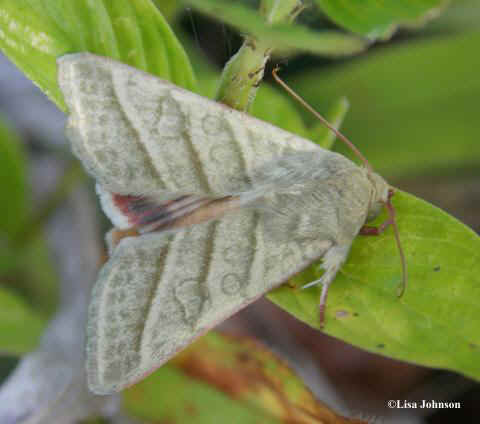
Tobacco Budworm Moth
(photo by Lisa Johnson)
Family NOCTUIDAE, Subfamily CYDOSIINAE
- Cydosia curvinella ______
M#9001 CR HN pb (BMCR:220)
- Cydosia phaedra ______ HN pb
Family NOCTUIDAE, Subfamily
DIPHTHERINAE
- Diphthera festiva ______ M#8560
BZ CR HN pb
(BMCR:230) (PNE:391)
HIEROGLYPHIC MOTH
The Hieroglyphic Moth is a distinctive species with a crisp black
pattern on an orange background bringing to mind ancient Egyptian artwork.
It will come to light.
Family NOCTUIDAE,
Subfamily EUSTROTIINAE
Moths in EUSTROTIINAE are
colorful small to medium-sized noctuids. They are nocturnal and come to
lights.
- Marimatha botyoides ______ HN
pb
- Marimatha sp. ______ HN pb
- Tripudia furcula ______
HN (species described in 2009)
Family NOCTUIDAE, Subfamily NOCTUINAE
Those below in the tribe
NOCTUINI are medium-sized moths with long, moderately narrow forewings.
They are mostly nocturnal and come to light, but some take nectar from
flowers during the day.
- Agrotis ipsilon ______ M#10663
CR
HN (BMCR:224) (PNE:517) (in tribe NOCTUINI)
IPSILON DART MOTH
The Ipsilon Dart Moth can frequently be found at sugar bait.
- Agrotis (or Feltia) repleta ______
M#10665 CR
(BMCR:224)
REPLETE DART MOTH
- Agrotis (or Feltia) subterranea ______
HN
(PNE:515)
(in tribe NOCTUINI)
SUBTERRANEAN DART MOTH
- Anicla ignicans ______ CR
(BMCR:224)
- Anicla infecta ______ BZ
HN (PNE:507)
(in tribe NOCTUINI)
GREEN CUTWORM
- Dipterygia ordinarius ______ CR
(100C:75-c)
(in tribe DYPTERYGIINI)
Moths in the following genus, ELAPHRIA, are
called MIDGETS.
They are small, highly-patterned brown moths with short rounded wings. They
can be locally common in woodlands and gardens. All are nocturnal and will
come to light in small to moderate numbers.
- Elaphria agrotina
______ M#9677 BZ HN pb (in tribe
ELAPHRIINI)
- Elaphria deltoides (phTM)
______ M#9679.1 BZ HN pb
(in tribe ELAPHRIINI)
- Elaphria perigeana ______ HN pb
(in tribe ELAPHRIINI)
- Elaphria subobliqua (phTM) ______
M#9682.1 HN (in tribe ELAPHRIINI)
- Elaphria sp. ______ HN pb
(in tribe ELAPHRIINI)
- Elaphria sp. ______ HN pb
(in tribe ELAPHRIINI)
- Hemieuxoa molitrix ______ CR
(BMCR:224)
- Hemieuxoa nezia ______
CR (BMCR:224)
Moths below in the tribe LEUCANIINI,
the WAINSCOTS, are medium-sized, mostly tan-colored noctuids, with
faint streaky forewing patterns.
Their distinguishing features are often subtle making species difficult to
tell apart.
LEUCANIINI species are often found in wetlands and fields. They are
nocturnal and come to light.
- Leucania inconspicua ______ M#10450.1
HN
pb (in tribe LEUCANIINI)
- Leucania multilinea ______ M#10446
HN (PNE:497)
(in tribe LEUCANIINI)
MANY-LINED WAINSCOT MOTH
- Mythimna unipuncta ______ M#10438
HN (PNE:495)
(in tribe LEUCANIINI)
ARMYWORM MOTH
Another name for Mythimna unipuncta
is the White-speck. The forewing is variably colored, from taht of
straw to orange-brown, with reniform spots that are often orange. A tiny
white speck touches the inner part of a reniform spot.
Mythimna unipuncta comes to sugar bait, and can be quite numerous.
- Neophaenis respondens ______ HN
(in tribe DYPTERYGIINI)
- Peridroma semidolens ______ CR
(BMCR:224)
- Praina temperata ______ CR
(BMCR:224)
To Top of Page


 A
List
of Some
A
List
of Some ![]()

















































